Expedition to Tajikistan 2010
All travel reports are translated electronically although minor improvements are sometimes made.
Expedition to Tajikistan 2010
A trip to Tajikistan is quite a challenge. Tajikistan is one of those countries which looks good in photos and it is nice to read about, but traveling through it can turn out to be a ‘heavy landing’. The Pamir Highway is picturesque, adventurous and it opens eyes to the unknown world. The Pamir Highway also shows dramas and the simple life of goat shepherds in remote areas, but it also provokes to reflection on how lucky we are that we can only visit that place. For me Tajikistan is primarily about dramatic mountains, open spaces, blue lakes in the mountains and the famous Pamir Highway. Unforgettable to me was also the Wakhan Valley shared with Afghanistan. Tajikistan was one of the best adventures of my life.
Expedition to Tajikistan 2010 – travel report
The Gorno Badakhshan Autonomous Region:
- The Pamir Highway (the Tajik part)- Kyzylord, Karakul, Lake Kara-Kul, Murgab, Alichur, Jelanda, Khorog. (A description of the expedition after the Pamir Highway on the Kyrgyz section for: Expedition to Kyrgyzstan 2010 ).
- The Wakhan Valley : Garam Chashma, Anderob, Ishtar, Khaka Fortress, Darshai, Ptup, Fort Yamchun, Bibi Fatima Hot Springs, Yamg, Vrang, Abrashim Qala Fortress.
- In addition, my report includes many interesting descriptions and practical information: about people, transportation, road conditions, contact with the police, the largest peaks, pamirian architecture and culture and many other topics. In this section there is also an explanation of what is the Badachsan Mountain, the Pamir Highway and the Wakhan Valley.
Dushanbe and around:
- Dushanbe,
- Hissar.
North Tajikistan:
- Trip on M34,
- Ayni, Istaravshan,
- Kojand,
- Lake Iskander-Kul,
- Penjikient,
- Marguzor lakes (Seven Lakes),
- a description of the road to Uzbekistan and a few words about the border itself.
As usual there are many descriptions of nature, road reports and practical information.
– – – – ♦ – – – –
The Pamir Highway
(What is the Pamir Highway, history and general information about the Pamir Highway, tourist attractions, about Marco Polo and his travel experiences in this area).
Before I go on to tell my adventures with such a very special place, I would first like to explain what the Pamir Highway is all about. The Pamirska route, which is a stretch between Osh (Kyrgyzstan) and Khorog (Tajikistan), is 728 km long and is the second highest in the world (4655 m), just after Karakoram (the highest point of 4693 m) connecting China to Pakistan. This route, also known as M41, was built by Soviet military engineers in 1931-1934 to facilitate the transport of troops and weapons into this very remote corner of the Russian Empire. Unfortunately today it is also one of the main drug routes and the traffic on the road is small. Usually there are several Chinese trucks that go with the goods from / to Kashgar. The Pamiri section was also one of many transport parts on the Silk Road .
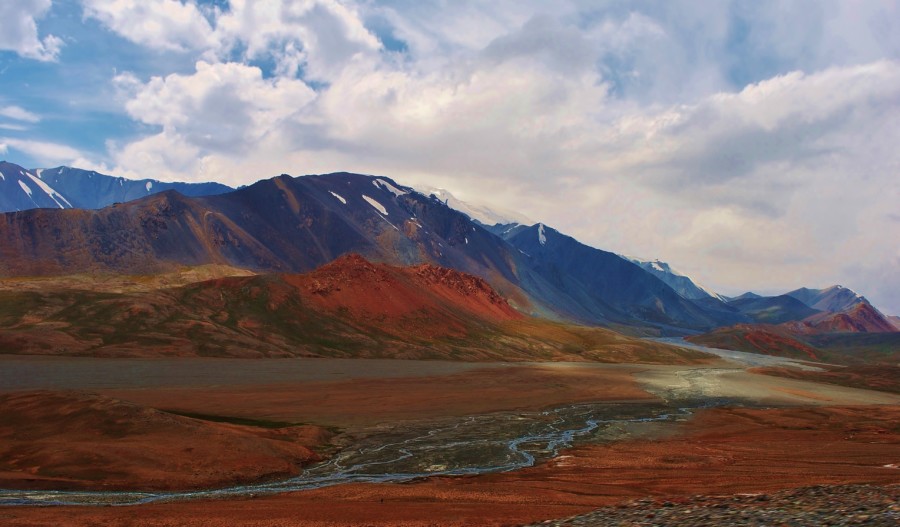
Pamir Highway, Tajikistan.
Pamir Highway is also a very attractive tourist area as the road runs through picturesque mountain scenery of over four thousand meters above sea level. The views are magnificent as there are desert areas, mountains, lakes, hot springs, glaciers, views resembling Tibetan heights and small Pamirian villages with their hospitable locals. The road itself is very incomplete because of earthquakes, erosion, earthquakes and avalanches. Asphalt in some places no longer exists and in others it is torn off with the surface of the earth, which of course gives an extra impression of the journey. In the lower sections of the route (the stretch from Jelanda to Khorog) the elevation is reduced so nature is changing and it is still beautiful. You can see a swift river, huge rocks on the sides, vegetation and more villages and people. In this area there are also two seven-thousandths with rather tragic names: they are Pik Lenin (7134m asl) and Peak Kommunizma (7495m asl).
Pamirska route was known many centuries ago because it was a famous Venetian traveler Marco Polo. In his ” Describing the World, ” he wrote that for a 12-day non-stop he rode through a plateau called Pamier where he saw only an empty tent without any vegetation and even flying birds. He wrote that the fire did not give him much heat and light as he expected because of the great cold.
Pamir Highway is still a great challenge for travelers and equally great adventure to be prepared well. I went to her wandering quite insignificant though everything I did and so successful. Undoubtedly, the biggest problem here is transportation, which is considered a luxury. You can stand many days with a frozen finger on an empty road. You also have to bring your own food, a tent and everything you need.Equally well, all this equipment may prove unnecessary because much depends on the transport.
Autonomous Mountain of Badachszan
It is also worth mentioning that the Pamirska Route is located in the Autonomous Region of Badakhshan ( GBAO ), ie the poorest, least populated and perhaps the most attractive for natural beauty. There is also the beautiful Wachan Valley in Badakhshan , which I will tell you about later.
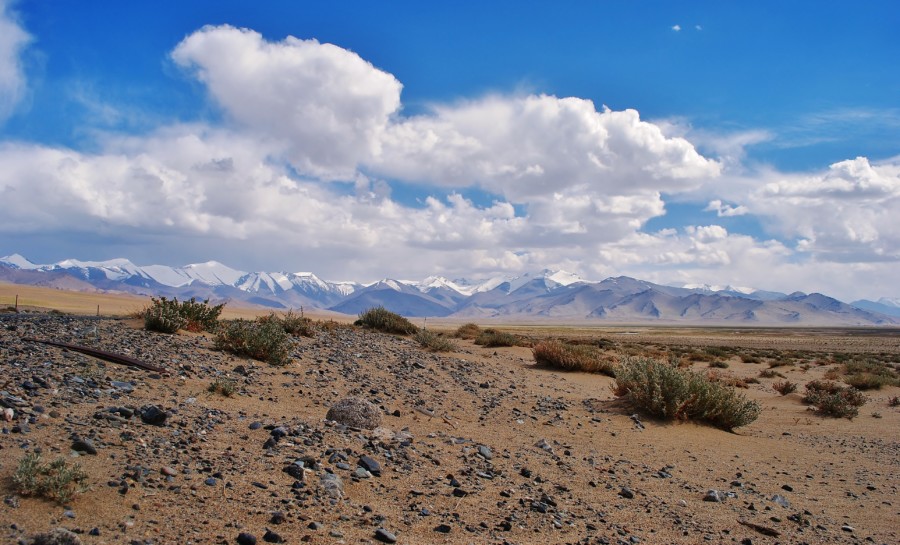
Pamir Highway, Tajikistan.
My trip through the Pamir Highway (Tajik section)
Kyzylord – the Tajik border
This border is one of the highest in the world because it is located near Kyzyl-Art Pass (4282m above sea level). The view from here would be beautiful but we could not get away from the car. Our driver took all the passports and went to one of the barracks after the stamp.
A rusty column with the inscription Tajikistan and a map of the country and a monument to the sheep of Marco Polo appeared before us. This is the moment when you have to look back to admire the beautiful panorama of Pamiru.
We also met two Dutch bikers who were finished but did not give up. To sum up, the Tajik border on the Pamirska Route has gone smoothly.
Riding from the Kyzylord border to the village of Karakul
I was very lucky that my Japanese and Koreans took me with them. I was sitting in the trunk with my backpacked but still had a good view. Immediately after crossing the border, another welcome sign with the inscription “The Upper Badakhshan Nation welcomes you”. Next to it was an iron, rusty yurt. I felt great at the time, as always when I entered a new country but this time it was something very special. I was traversing the Pamir Highway. There was an absolute nothingness, a wilderness, ponds, mountains and open, empty spaces at an altitude of 3500m above sea level. Many times we stopped on an empty road to take pictures of beautiful nature. It was another great adventure.
Karakul village (4100m asl)
(Description of the tragedy of the settlement on the background of the beautiful nature and hospitality of the people)
Karakul village, located 63km south of the Kyrgyz border, is basically the only apparent settlement. It is also a very tragic collision with the Tajik reality in the pamirskie section.
Karakul is also the first stop on the road from Kyrgyzstan. Karakul village is a row of several clay and brick houses in complete desert. Not all of them had roofs so they were not inhabited, and from those that were, wooden logs came out. We immediately went out to greet people and one girl invited us all to the house.We sat in the kitchen on the raised floor, which is typical of Pamiri houses and the hostess gave us bread, jam, green tea and yak butter. Those people were mostly Kyrgyz, though there were also several Tajiks. After a while, there were also children who rushed to candy bars bought specially for this occasion. It was very nice, the food was definitely very fresh but the extreme poverty from all angles and people’s eyes made me sad. Still, the housekeeper did not want the money because she said she did not take the money. After a meal I wanted to see Karakul better.
For a dozen clay, gray and sometimes hollow houses ran a sandy, sandy road with scattered stones. There were pits, hills, rusty car wrecks, idle people, and stone dumps. I noticed that just as before in Tibet, here I also saw a pile of slaughtered manure. I guess I am also in Tibet, so here they serve to warm up homes by gluing on the walls, though mainly fuel. In Karakul there was also a mosque and probably the best looking building in the village and a tragic playground where children did not enjoy it because it was too depressing. The views, however, to the mountains and to the surrounding lake were wonderful.
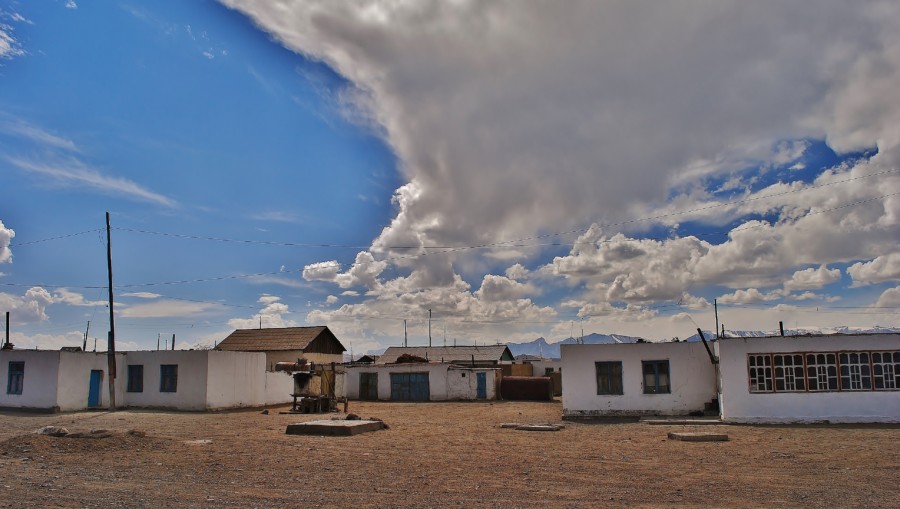
According to the contract I was supposed to stay in Karakul here to wait for the next transport but the Japanese and our chubby driver took me to Murgab. I wanted to spend one night here but when I asked how much I would have to wait for the next transport, I was told “the car should arrive in three days”. I did not want to count on luck and wait indefinitely or go on this road on foot. As I was told, the village of Karakul to Murgab is 125km which in these conditions can mean eternity.
Lake Kara-Kul (3914m asl)
(Some information about the lake and my experience)
Immediately behind the village is a beautifully located, Kara-Kul lake. Established about 10 million years ago by the meteor strike Kara-Kul lake is deep and blue although the local Kyrgyz region is called “Big Black Lake” because after sunset it is just that color. It is the highest lake in the world except in Tibet, and is even higher than Lake Titicaca (3811m.pm) on the border of Peru and Bolivia. Lake Kara-Kul is salty and covered with snow and ice until the end of May and due to its high position it is not stocked. It has 380km 2 , lies in two waterfalls and is divided with shallow 8km long and 4km wide. You should not confuse this lake with another Karakul Lake (3600m asl) in western China, on the Karakoram Route.
That day was just good weather for that height. It was windy and cool though the beautiful phenomenon was clouds nicely arranged in the sky and bouncing off the mirror of water. The area around the lake was wet and white from salinity. I had to jump from dry to the other. I spent about two hours strolling around Kara-Kul and taking pictures of nature and goat-goat against mountains. This place is also a good opportunity to find nothing worth but very original souvenir. From the wet ground several times I raised the skull of the goat and the big horned horns. Lake Kara-Kul was another beautiful experience. Basically no matter which side would go Pamir offers beautiful views.
Road from Karakul to Murgab
All the way, of course, I enjoyed the views and made a lot of pictures. We drove through the beautiful wilderness surrounded by mountains. For many miles to the left we had a view of the stretched Chinese border, or fence “adorned” with barbed wire. I noticed that although the mountains were high they did not look as high as I thought, as we were driving at an altitude of almost 4000m above sea level and one of the peaks, Mt Urtabuz had only 5047m above sea level . From the Pamirska Trajectory, which was already so high, the mountains and their peaks looked low. There were rocks of different colors. Mostly beige and red, some covered with snow and with the eye to reach, vast deserts. Then we passed the highest point of our route, the Ak-Baital Pass (4655m) at the same time just before the view of the Muzkol peak (6128m).
Besides, the Pamir Highway was full of many other attractions and one of them was the same road. It is very incomplete and uneven due to earthquakes, erosion, land collapse and avalanches. Asphalt in some places no longer exists and in others it is torn off with the surface of the earth, which of course gives an extra impression of the journey. In some places the asphalt road was very narrow and for example the moment we crossed the section with a gap on both sides and a river near by, raised the pressure. After the first day in Tajikistan and after many attractions with this country bound, we reached Murgab late in the evening.
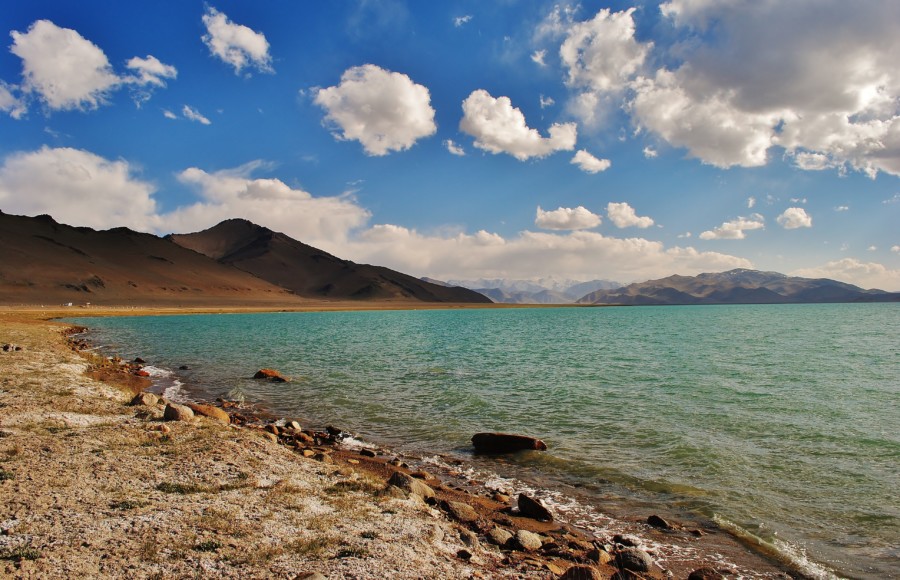
Murgab (3800m)
(General and practical information about the town, exchange of money, register to the police or not, arrival at the guest house and brawl with the driver for money, initial altitude sickness, detailed description of the village, problem of waiting for transport)
Murgab is the largest settlement on the Pamir Highway after the capital of the Autonomous Region of Badakhshan- Horog. Murgab is a very interesting experience showing the poor, tragic reality of life in Tajikistan. At first glance this is an empty, dusty road and below are clay houses and a primitive market, but it has its charm if anyone is interested in an expedition like this one. The town itself does not have anything enchanting beyond the picturesque views of Pamir . The Chinese border is only 10 km from the settlement and therefore on a nice day you can see the Chinese peak of Muztagh Ata (7546m above sea level). Murgab is also a good place to organize excursions to more remote areas of Pamiru, which obviously involves additional costs as public transport simply does not exist. This village is divided into two communities – Kyrgyz and Tajik, and from what I know there are minor problems between them and all the disturbances of course, of course, the unusually poor economic situation. Current in Murgab exists but there are breaks in its delivery and the intensity is so small that it takes hours for the bulb under the ceiling to start glowing with full light.
It is worth mentioning here that Murgab is the last place on the Pamir Highway where Kyrgyz somas are still accepted, and when traveling in the direction of Khorog, they must be mentioned here in the Tajik somani . When I was here the course was very easy: 200KGsom = 20Ts. (After the current course I would advise you to look at the exchange rates on my website.) The second important question is whether you need to register for immigration police or not and Murgab is the first opportunity for those who are leaving Kyrgyzstan. There are many unexplained gossip on the subject and contact with the Central Asian police does not bode well. Still, I wanted to get the first hand information to make my report more credible.The rules may change, but in August 2010 I was told at the police station at the Lenin Monument that tourists staying in Tajikistan for up to 30 days are not registered . Still my name was written, but especially in this country I was on a roll.
We reached Murgab in total darkness very late in the evening but our driver took us to the guest house. It was a house run by a Kyrgyz family at the very top of Murgab. To the right there was a staircase and a shower room where you could wash after getting a hot water bucket, and on the left stood a yurt. I spoke Russian so they gave me a super $ 5 discount but they said “Japanese” have to pay $ 15. Because the “Japanese” were so nice to me that they had taken me through the stretch on which the transport was bound by the miracle, I also wanted to be nice to them. So I bargained for $ 10 with meals. But the problem was with the driver and how it relates to money. The Japanese paid for the whole course and they did not want any money from me, but the driver wanted me to pay him $ 50 because taking me was not in the plan. When I said I did not pay, he started throwing and lugging my luggage, then headed to the exit. Of course, he was very naughty and broke my camera. At last I shot him from his elbow to his mouth and at that moment the situation changed. In a great row we sat down, gave him $ 20 and he said “haraszo” and shook my hand. Of course there was a little bit of jarring and threatening on his part, but I thought that in all it was me and $ 20 would not ruin me. I saw the Kyrgyzers respect me and said that I would pay only $ 5.Soon the driver left and everything came back to normal. We went to sleep after a day full of impressions.
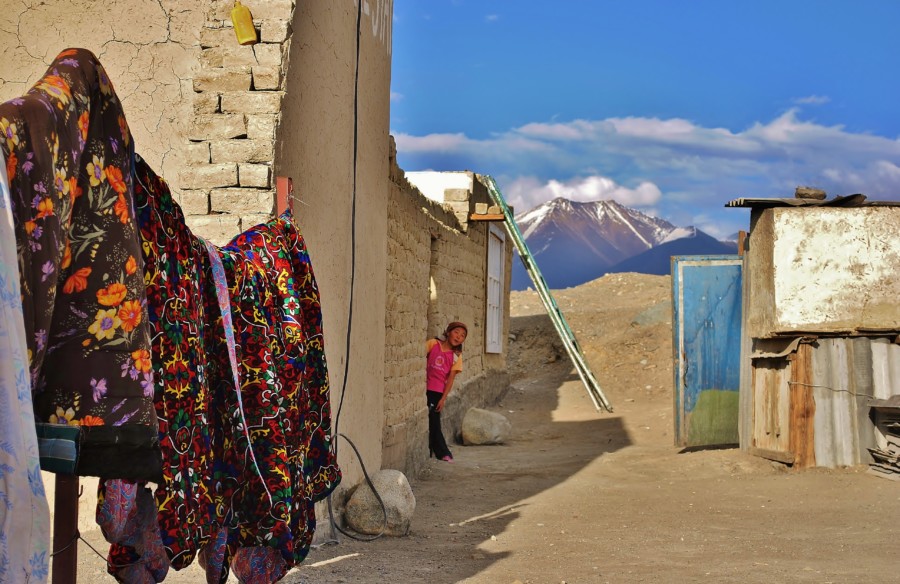
The next day I woke up with a big headache because of high altitude disease. I did not faint, I did not run to the crock and I did not see double but I had a big headache. Finally, Murgab is at an altitude of 3800m and over the last few days I have had many violent differences in altitude and have not had time to settle down.Still, I was able to do it myself. Firstly we went to the dining room where we were served breakfast. It was obviously bread baked in the oven outside, butter jams, natural yogurt and green tea. I met many travelers with whom I could exchange information and talk about our experiences. Many of them traveled the Pamir on bicycles, which I think was a great feat. After breakfast, I left the house to look closely at the village. I lived almost at the top so I had to descend down to the main road. I continued to walk with headache through the uprooted sand until I reached the road and tragically looking homes. Some of them were brick and other clay and not all of them were habitable. Between them were the streets, also from the ground, over which dust rose. I was often accompanied by dirty and poorly dressed children where the elderly looked very young. Against the clay houses and car wrecks, they rode on rusty bicycles.
After a while, I reached the end of the road where another violent fall of the earth was. From here I had a view of the mountains in front of me, the women washing in the river and the nail of the program, the local market. So I went down to look at him closely. On a flat, deserted desert, where each passing car added its portion of floating sand, steady cars with vegetables and fruit, and on the other side were iron, rusty containers converted into shops. You could buy all the stuff you needed because the bazaar was even well stocked.However, the character of the place itself was beyond imagination. The bazaar in Murgab is in my opinion one of the best depicted Tajikistan places. The local Kirgyzos are also nearby, in their national caps, on a clay background, leaning against a car wreck, with a cigarette and a sheep for sale. On the other side was also a butcher and it was another groundbreaking experience. In the brick yurt, the Kyrgyzers just beat the ram and other animals hung on the hooks, leaning against the dirty floor. There was a lot of blood here, and any sanitation needs to be out of the question. In the same place there was a transport point where unemployed taxi drivers could wait for many days for the passengers.
Then I went to the other side of the village to Yak House . Here was a souvenir shop, tourist information and incredibly expensive internet. On the way back I had the opportunity to take a closer look at the “town”. Of course, I was walking through smoke, poor houses, and encountering poor children. On my way I also had some huge holes, deep for at least 5 meters and long at 10. Then I came back through the main road through my “desert” to the hostel. I was given a light dinner, I talked with the travelers and once again I felt a great headache caused by height. At the entrance of the hill up to the hostel stands a monument representing friendship kirgisko-Tajik. There are two flags, two emblems and two hugged hands. In the afternoon I went out again and this time passing the market I crossed the river to get closer to the mountains and to see the interesting mosque. I went further behind the village, sat down beside sheep and sheep, watched mountains and women making laundry and laughing at me. It was beautiful but the plague of mosquitoes got me out, which even in late August is unbearable. As I approached the darkness, I returned home by the circular road. Going through the police station and Lenin’s monument, some better houses and sand, my eyes, I climbed up one more and reached home.
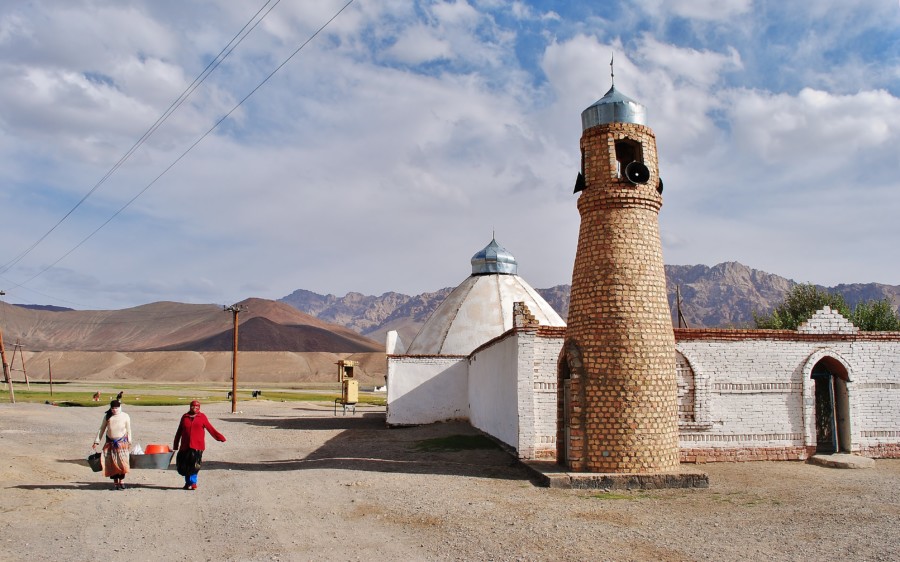
The next day I wanted to get out of Murgab which proved to be very difficult. I had the opportunity to experience what it means to be on the Pamir Highway . At the main bazaar taxi drivers have been waiting for a few days to set up passengers so the fight was fierce. I waited about six hours and although the driver assured us that we would leave soon, we did not expect it. Somebody wanted to pick me up, but the taxi drivers made him a fuss for getting them out. In the meantime, I talked with the drivers. These were mostly questions about Europe and the statement that I was “stuffed” hundreds of dollars. Finally, in the moments of desperation and the government of any money they began to call me a “millionaire”. After six hours of waiting and staring at the unshaven and snuggled drivers, I thought I would stay at Murgab for another night …… or two … or three … and so endless. It was too late to catch Chinese trucks that day, so I tried my last chance. I pulled out of the bazaar with my backpack and I stood 100m away on the extension of the same road. After 10 minutes a small, grandfather, Chinese car came. I stopped them and asked, “Will you take me to the Khorog?” They say, “70 somani, get in.” I bargained to 50 somani and I was happy because I found myself in the luxury of this area of the world situation. I moved! From experience I know that no matter how to forward.
Murgab was a wonderful experience that opened my eyes to what Tajikistan really is and the Gorno Badakhshan Autonomous Region .
Practical information about transport on the Pamir Highway
On the margins, the distance from Murgab to Khorog is 310km and driving in these conditions and mostly poor transport and after a poor road occupies all day. You also need to include the length of the wait, which depends only on luck. Even so, transport from Murgab to Khorog is still easier to find than the Kyzylord (Tajik border) to Murgab. This is one of the reasons why many people travel through the Pamir Bike Trip , although it is always a good but lazy donkey. All day riding from Murgab to Khorog is very good news as Pamir has a lot to offer. I advise you not to go straight to Khorog but stay on the road in Alichur and Jelanda .
Chinese trucks are “hit or miss” although you should not deny this option.
Ride from Murgab, through Alichur, to Jelandy
The ride from Murgab was very pleasant as it was full of great views of Pamir. I was driving a small Chinese car on an uneven, hollow road with a cheerful companion and talking about life in Europe and in Tajikistan. The views were beautiful, as the mountains were always surrounded by mountains and the pistes were wide. Sometimes the rocks were from red sandstone and on the way through the Naizatash Pass (4137m) and picturesque red valleys, we stopped the donkeys who did not want to get off the road. I thought that day would be the only traffic on the Pamir Highway, but I also saw a Chinese truck going to Murgab. After a few hours we reached a small village near the road to Alichur (4080m asl) .
I also recall that after leaving Murgab we had police control which is notorious in Tajikistan. Each time I write my passport data, and each stopped car must give the policeman a “paw”.
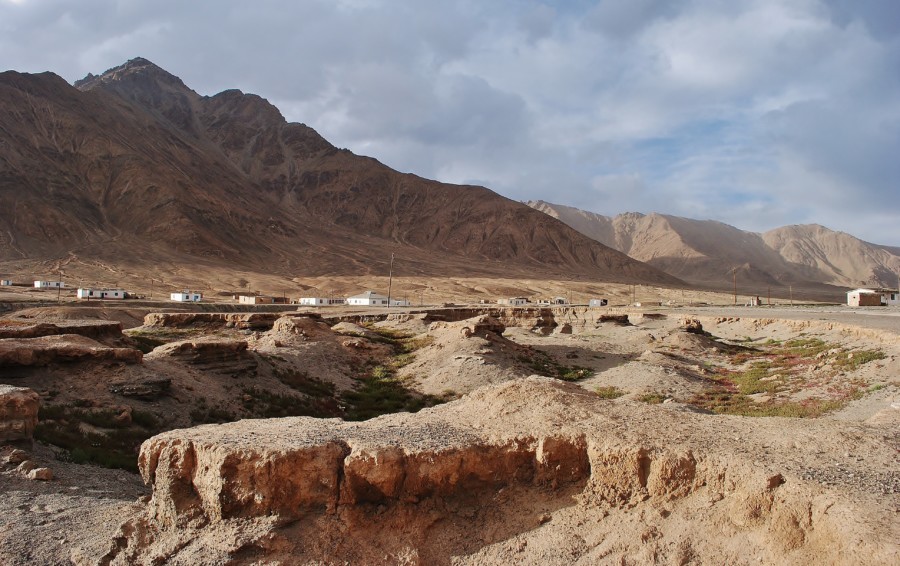
Alichur (4080m above sea level)
…… is a small, gray bura, a very poor village, which forces me to reflect on what great happiness I have that I was born in Poland. Just as before, in the gray desert, there were many clay houses separated by a road from a crushed earth. In addition, there were pens in which often pancakes were made of animal manure and several parts of local sheep species. Outside, there were poor children posing for photos of wrecks and tragic surroundings. This place reminded me a little Tibet …… my miserable Tibet.
In Alikur I went with the drivers to one of the houses where it was very nice. The hostess was taking tourists from Germany who traveled the Pamir Highway on bicycles. She spoke English and had a very nice, about 20-year-old daughter who worked all the time at home and studied at the Central Asian University in Khorog. They gave me green tea, natural yoghurt, buttermilk and Tajik kumys. Contrary to Kyrgyz, this was good because here it is made out of milk instead of kosher.
Shortly after, we set off on our way. Driving through the hill, two lakes appeared on the right side of the road. They were Sassyk-Kul and smaller, Tuz-Kul . They covered a vast valley surrounded by red-beige mountains. Just before reaching Jeland, there was another elevation called Koi-Tezek (4272m). In this section the route was in terrible condition and it was almost vertical. We had a problem because in one episode a piece of road fell into the abyss, and the car was driving in the opposite direction. My driver, however, managed and happily reached Jelanda.
Jelandy (3800m)
(Description of the area, hot springs, lack of electricity and transport information)
Jamaica is a well known resort where there are many hot springs. Mostly they are old though one is located in a new home where there are plenty of rooms, a pillar and two large hot water pools. However, we must remember that Jelandy is one place and we are talking about the Jelandy Sanatorium or the Resort . You see it from the main road but you have to get there after a fatal road across the bridge. The Jelandy lies in the beautiful surroundings of mountains, pastures and a strongly rushing, turquoise river.The good news is that there is a regular transport to Khorog. Once a day, in the morning when a small Chinese bus is full you can happily get to the place.
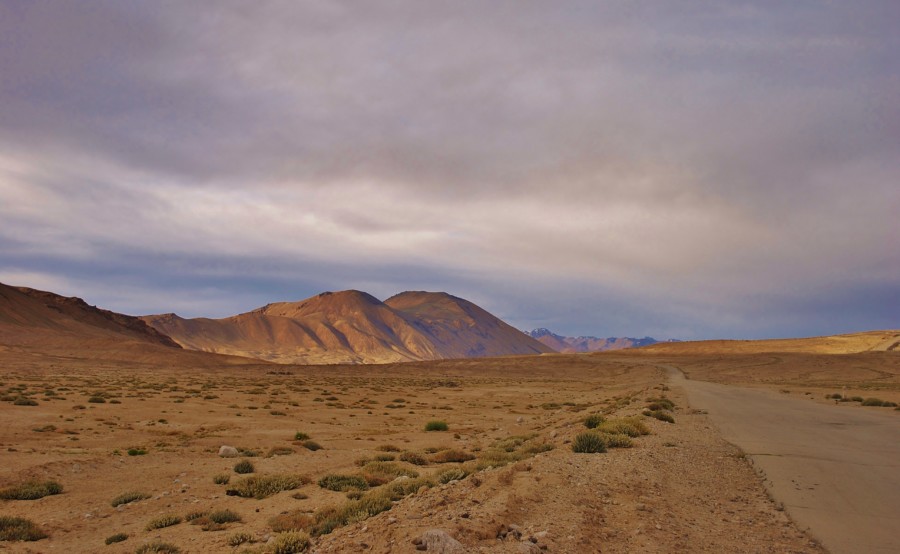
Pamir Highway, Tajikistan.
When we arrived in Jelandy it was already dark and obviously there was no electricity what should not be considered unusual. The drivers were so nice that they took me to the hotel and talked to me about it. I got a room for only 20 somani which is about $ 4.5 with the possibility of using hot springs without restrictions. I paid 50 somani, took luggage, and felt that I just wanted to take a bath. Using my flashlight I reached the room and then went to the source. The water was wonderfully hot and very pleasant, especially after traveling on the Pamir Highway where even the smallest thing is luxury. In the pool I also had a conversation with the Tajiks and I would probably have to do with Chinese truck drivers but unfortunately I did not speak Chinese. Then I went to the canteen where the old script was repeated. I got a long menu but that day it was just chicken. The next day for breakfast was only porridge.
The next morning I came across a neighborhood, went down to the river and admired the views. I had time for this, as the driver going to Khorog had no passengers. Unfortunately I did not take any pictures then because I could not charge the battery from the camera.
To sum up, Jelandy is a very relaxing and in my opinion even necessary to stop after hard times in Pamir.
Travel through the Gunt Valley from Jelandy to Khorog
(Description of beauty of nature, nice people, police station, lack of electricity by 310km)
Gunt Valley in my opinion (and other travelers probably also) a completely different section of the Pamir Highway. It is an area from Khorog to Jelanda where, due to its lower altitude, there is another nature.Here, despite the surrounding beige mountains, it seems to be cheerful because it is warmer and has a lot of green. Also a turquoise river and green ponds on the backdrop of mountains and trees add to this part of Pamir more charm. There is no mention here of the huge, multicolored boulders standing by the river. The Gunt Valley, in contrast to the description above, is much more populated, which means a lot of good experiences from this place. The entire stretch is full of typical houses and farmhouses built of chopped rocks, in a beautiful natural scenery and a great asset are also very nice, hospitable and also very interesting people. (More on this in the story of my bike tour of Gunt Valley ). It is worth mentioning that unfortunately I could not make a single picture here because the battery from the camera was exhausted and for 310km, since leaving Murgab there was no electricity. That’s why I’ve been working hard to get back on my bike.
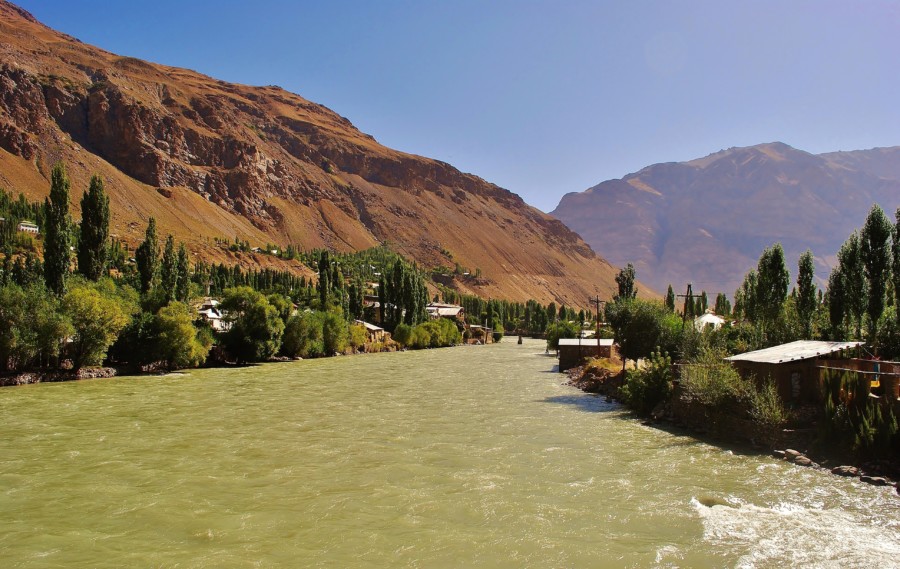
There was a police barrack waiting for us to enter Khorog. We all had to show the documents and driver’s car documents and some somani to console the cops. Soon afterwards we started climbing and passing through concrete tunnels built on the edge of the road. These tunnels were here because of the prevention of avalanches, which occasionally haunt the road. On the wall of the last tunnel there was a relief “70 years of the Soviet Union” and a sickle and hammer above. (By the way, all the cars in Tajikistan have a broken windshield, because there are mountains everywhere and boulders fall everywhere). The view from above was obviously beautiful. I saw more mountains, including glaciers, and a wonderful turquoise river. Then we drove to Khorog and just before the town on a great boulder, along the road stood the concrete sculpture of the Marco Polo sheep . The views and the “climate” of the place – great!
Khorog (2100m above sea level)
(Description of the town, description of the hostel, bazaar, Par Central, pamirskie socks, regional museum, botanical garden, natural beauty of the area, bargain on the Afghan border with Afghan merchants)
Khorog is the capital of the Autonomous Region of Badakhshan. It is a small but charming town situated at an altitude of 2100m, cut by the Gunt River and “decorated” with mountains on each side. Khorog is, in my opinion, the only place on the Pamir Highway on the Tajik side, which deserves to be called a town. Unlike the rest of the lovely and certainly very interesting settlements, Khorog is not tragically poor. Another thing is that it is about two times lower than the other settlements so it is surrounded by greenery. There are banks, a vibrant bazaar, a museum, the University of Central Asia, the internet, shops, restaurants, post offices and asphalted streets, which are not everywhere. A few kilometers from the center of Khorog, the Gunt River connects with the Pandan River, which is also the border with Afghanistan. Khorog also has an Afghan consulate, which “depends on humor and weather” issues visas without sending tourists to Dushanbe.
After arriving to the town, I was most fortunate that I was able to fulfill my next dream. Without any obstacles and with great luck I managed to travel the Pamir Highway. My driver drove me to the Pamir Lodge on Gagarin Street, which is located across the bridge, upstairs, near the football pitch. The hostel was located in a nice garden, built with pieces of rocks and also surrounded by a rock wall. Here I was waiting for great deals because I had three payment options: in the room for $ 6, on the terrace on the floor for $ 5 and in my own tent in the garden for $ 4. Of course, I chose the cheapest option because I have not financially improved after traveling with my Monika. This day I spent in Khorog to get to know the town well. I stepped down from the top and crossed the bridge where a gorgeous, turquoise river snapped me up and where I looked at the surrounding mountains. Then I turned left and across the street full of houses I reached the local bazaar. It was one of the most interesting places that gives a good insight into the Badach bazaar, the people working there and the interesting whole of this place. The market was full of diverse goods from vegetables and fruits to fine items and a rich selection of cheap chocolates from China.I recommend the local pubs where the menu is very unkempt but once you give in, the food is very good.At that very occasion I had some interesting conversations with local people. I also recommend the bridge from the back of the bazaar, which has a great view of the Gunt River and the mountains. This bazaar is also the best place to organize transport to Dushanbe and to all other places. Across the street is a rather disgusting “croaking” toilet and next to the Tajik-Russian Friendship Monument. Behind the bazaar there is another park where there is another monument and a great painting in honor of World War II, presented to the glory of the Red Army.
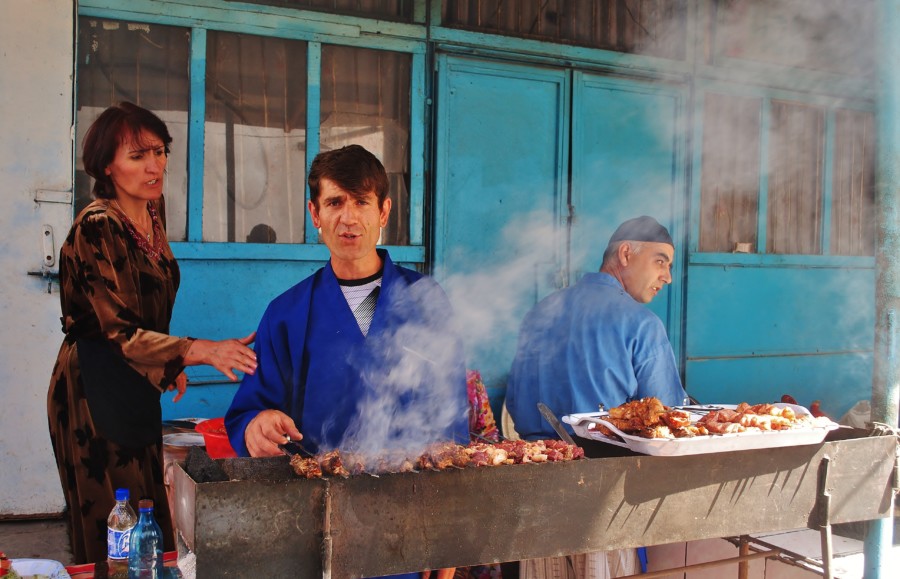
On the way back I was in the Central Park , which I have to admit is a very pleasant place. In the middle of many trees there is a playground built traditionally from the rocks and the shop De Pamiri where you can buy traditional, pamirskie products. But it is very expensive, so it is cheaper on the bazaar I was before, and on another 2km away where I bought traditional pamirian socks. The Central Park is located on the River Gunt and there is also a swimming pool with water from the river. The whole is lovely and it is a good rest from the bazaar and the busy road.
Another interesting place to recommend is the Regional Museum, where, apart from Stalin’s picture and many memorabilia connected with Lenin, there are also many exhibits, everyday objects and art of the autonomous region of Badakhshan . Noteworthy here is the piano, which the Russian soldiers on foot brought to the Khorog of Osh. You can see that the red army is from the steel because in the 10th they beat 728km or the entire Pamir Highway.
After lunch at the pub near the post office I crossed the bridge again and stopped one of the taxis, a small Chinese bus. For only 1 somani, so much as I was taken to the Botanical Garden (3900m asl) , which is the second highest in the world. The road was very picturesque because we were moving around the mountains, near the rushing river and at houses built of rocks. When I reached the gate of the Park I did not realize that almost 2km of climbing was waiting for me. Fortunately, I met young Tajik and their attractive sisters. Although their car was clogged let me sit as a second passenger on a one-seater front seat and so I got to the top. The Khorog Botanic Park includes several hundred acres of woodland, gardens and rocky climbing cliffs. I spent many hours with my companions eating apples and pears, but even when the boys were away the girls posed for me sexy photos. I see that in my presence they felt free. The area itself was a good experience but there were not as many different species of trees as in the Sri Lankan botanical garden.
The great advantage was the beautiful view of the surrounding countryside and the river. It was a nice experience and not just my opinion. The President of Tajikistan has a luxurious dachshund so he likes it too. Then I came back with friends down and walk, near the river, in the background mountains I came back to the town. I spent long hours enjoying the beauty of nature and tranquility. After shopping I went back to my hostel again climbing uphill. That is Tajikistan. Wherever I went I always had to climb somewhere. I spread my tent on the spot, got a green tea and a bucket of boiling water so I could finally get a bath. It was also a great experience since I had not had a chance to wash since I left Kyrgyzstan.
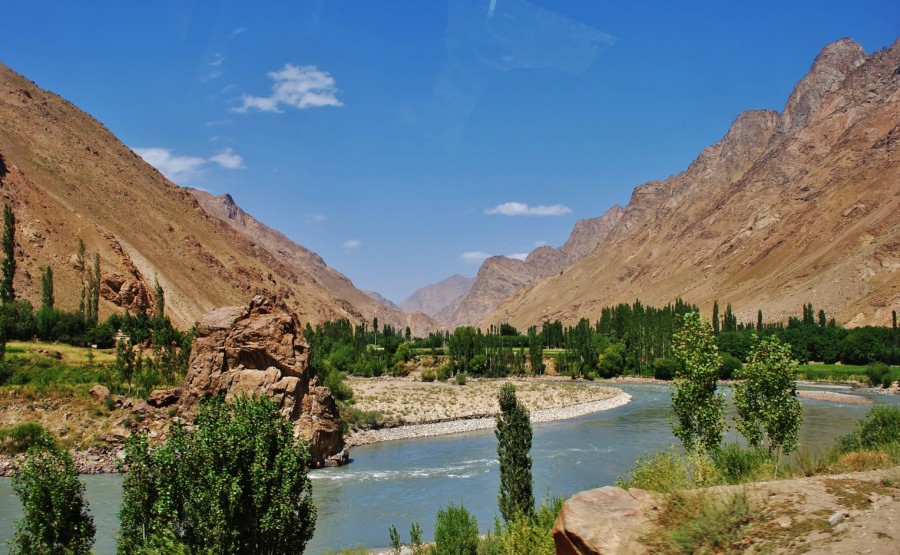
Khorog is a very pleasant mountain town where you can celebrate the Pamir Highway and where there are many interesting places. One of them is a Saturday bazaar on the bridge 5km from Khorog, on the border with Afghanistan. I was not there because I did not want to wait until Saturday but I had information from other travelers that it is quite safe and you can come across many interesting goods.
My bike tour through the Gunt Valley
(Natural beauty of the Gunt Valley, money laundering, helpful and curious people, donkeys with a brushwood, Kafir-Qala fort in Bogev village)
On the way from Murgab to Khorog I did not have electricity so after leaving Jelanda I ran out of battery in the camera and could not take any pictures. That’s why I decided to go back to Gunt Valley. I was lucky because the hostel was a nice French guy that one of them lent me a bike. Without that I would not be able to see this part of Badachishan as I did it on my bike. On that day I beat 30km there and 30km back and it was a well known route. Immediately after leaving Khorog I saw a statue of a sheep Marco Polo and then I had a hard climb up the hill until I reached the tunnel with the words “70 years of the Soviet Union . “Hence the view of the river and the whole valley was beautiful and I have stayed here many times to make the best photos. Then I quickly drove off the hill but I had to hold the steering wheel very hard because the road was fatal. Then, unfortunately, there was a police barrier and here I had a great example of how local police work. At the sight of the tourist try to evade the lies of course to get any money. Officially, they are making a registration. The local clown told me that I do not have a permit in the passport to ride this route and that is why he wanted $ 10. I had to explain to him the broken Russian that I was not an idiot and that the Tajik Embassy in London claims otherwise. He gave me a passport and said goodbye.
The rest of the route was a pleasure. I drove a beautiful valley, near the river and had inseparable mountains on the sides. Sometimes they were rocks of very interesting, original shapes, picturesquely integrated into the environment. I walked through a pair of wooden, hanging bridges and talked with the people I encountered. Many of them were very interesting. They invited me for tea to ask me about everything but it was never intrusive. Many people helped me reach some places and give me fruit. I met the hosts with donkeys carrying chrust, people gathering fruit in their orchards and each time was very nice. One of the buildings I managed to reach that day was the ruins of Kafir-Qala Fortress . Although this property is located in Bogev village, only 15km from Khorog, getting there is not easy. I had to get off the road and climb up to see two ruined temples. The road itself is a great adventure that requires climbing and views from the top of the Gunt Valley are extremely attractive. Then I rode the main road and became a photographer at the most important places. One of them was a wreck of a car and a truck on the background of mountains and a cow walking around it.
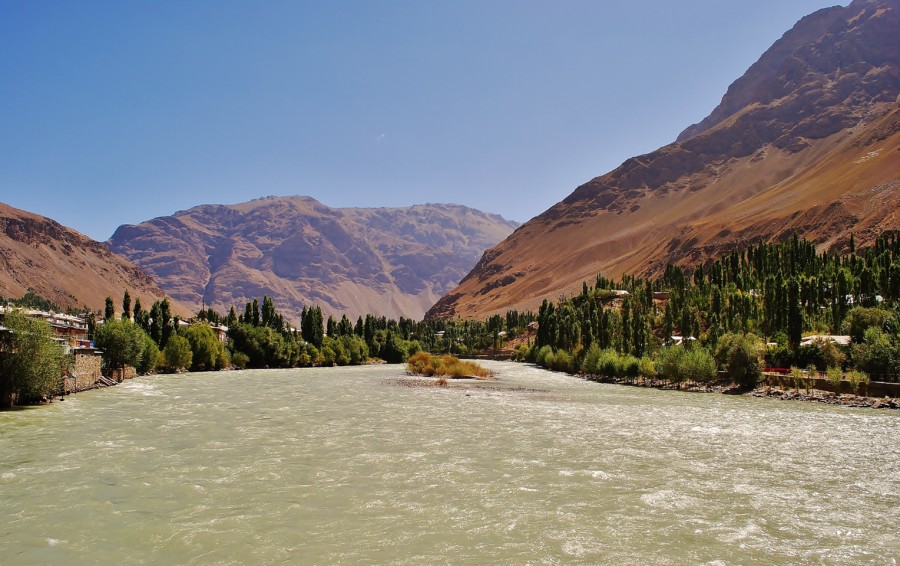
On the way back, the cops simply opened the barrier.
Wakhan Valley (Wakhan Valley)
The precepts about the Wakhan Valley, the way from Khorog to Garam Chamba, the hot springs of Garam Chashma, Anderob and his very nice people, the conversation with the militia, the road to Ishtar, including the ruby mine, Ishkashim and the nearest surroundings, stay with the Pamir family and traditional description Dacha, Ptup, Fort Yamchun, mountaineering, hot springs of Bibi Fatima, Yamg, Vrang, Buddhist Stupa, Ratm, Abrashim Qala, Liangar, return to Khorog with many interesting stops on car repair)
The Wakhan Valley is one of the most picturesque, secluded and adventurous parts of Tajikistan, to visit which I strongly urge. It is shared with Afghanistan and as a curiosity I will say that Marco Polo traveled this way in 1274. To travel through this valley, there is a need for a GBAO permit with the Ishkashim marked, which even a randomly encountered policeman will willingly check out for easy earnings. The Wakhan Valley comprises not only the beautiful whole of this place, but also certain villages, people, fortress ruins, hot springs, donkeys, natural soda water sources, Afghanistan’s continuous panorama and many other interesting things.
From the bazaar in Khorog, across the bridge I got into a Chinese van and drove to the best hot springs in the area. They were the famous and charming Garam Chama , 46 km away from Khorog. The road was there through a picturesque, uneven but fascinating road, especially on the other side of the river I had Afghanistan. The views were beautiful and the thought of getting into Afghanistan was not good for me.This section is densely populated by hospitable people who lived in traditionally built stone houses.
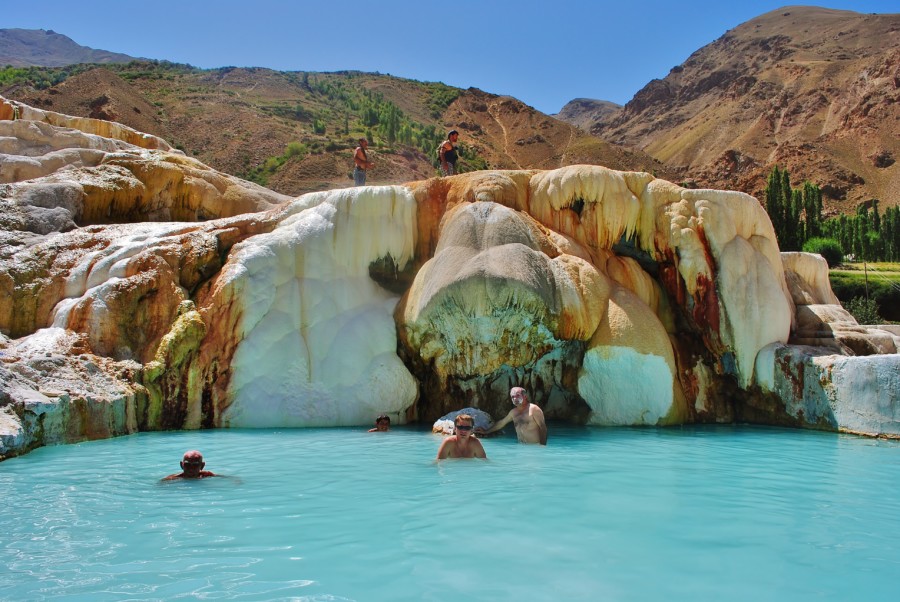
On the way there were also a few police blocks during which they wrote me each time. Upon reaching the place, rocks appeared in front of me where the gate and stairs appeared. There was a turquoise pool with natural, warm water surrounded by white soft rocks, which could be scraped, soaked in water and lubricated with them. All this for the healing properties of the rocks. I also advise to climb up to the top of the rock where the source of the outflow from the center very well. This is how the pool is filled up. I spent a couple of hours wetting and smearing from the bottom of the pool. Finally they shaved me at the expense of the company. In my opinion, Garam Chama is a must have trip with Khorog. You can not miss this. If someone wants to stay overnight, it is possible.
As is often the case in Tajikistan, transportation is limited because I was walking 7km hilly road to Anderob, a small settlement at the crossroads. I’ve been playing here much longer than I expected because I was waiting for a 6 hour trip to Iseki. In the meantime I got acquainted with the whole village and got boiled eggs, bread and biscuits. The only time I had to wait for tea was because there was no electricity. We have been talking about a lot of hours about Europe and Tajikistan, my earnings, of course, and my family. I also witnessed a carpet rug in the street throughout the family, which is already ritual in Tajikistan because then I saw it many times.
When I lost my patience because of lack of transportation, I went to the police checkpoint to help me stop the car going to Khorog because I could not count on Ishkash. I sat down with them, drank green tea again, asked me everything and stopped my car at Ishkash.
A 30-year-old Uaz, a Soviet-made off-road truck, was fired on the crank in front. A boy about the age of 25 was named Gajrat, who for 30 somani took me to the village. The road was very uneven and attractive.Several times we were off the road and once we had to change the tire. All the time on the other side of the river we had a beautiful view of Afghanistan and live there. I’m talking about poor settlements and donkeys. Immediately after leaving Anderob I saw the mines of Koh-i-Lal rubies. We also stopped for a moment to get natural carbonated water from a nearby well.
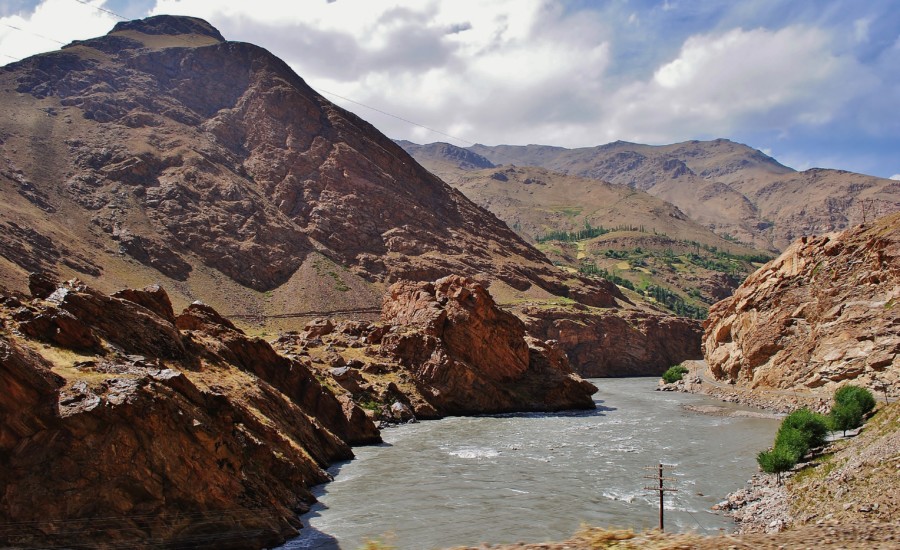
After arriving in Ishkashim, I stayed at a local family’s house for a night at my driver’s. I lived in a traditional pamirian house, which is built on specific rules. The explanation is quite a long story, but I will say in general that the construction of Pamiri houses is based on philosophical-religious principles dating back over 2500 years. Traditional elements include pillars and roofs, each of which has its own religious significance and philosophical message. There is a hole made in the form of squares. Another important element is the platform running around the room where you sleep and sleep. There are storage rooms and sometimes stove. On the margin the bread baking oven is usually out of the house and has every family there.
The host took me down on the platform and went to bed. The next day I went to see the area, that is, I went along the river Pihan , on the other side with Afghanistan . I talked with people and watched them at work in the field. I also liked very local houses made of chopped rocks and a couple of car wrecks beautifully incorporated into the surroundings. However, I did not give myself peace to Afghanistan, although this feat is a separate thread of my journey.
After a walk and a short visit to Afghanistan, I went back to my hosts’ house, ate breakfast and delicious apricot jam. This day I spent in the orchard at the hosts eating fruits though then I also went to the center of Iszkas. There was not much traffic and people did not always respond to my view well. Some wanted to smother me and others cursed behind my back when I did not want to do business with them, which would earn them $ 100. Ishkashim to the largest village in the Wachana Valley and at the same time a regional center, which can go long and wide in half an hour. The economic situation is very bad. On many occasions I had a conversation with my driver’s mother about having no money here. She also said it looking into my eyes with great envy. Her two sons worked at a local bank. One earned $ 50 and the other $ 100 a month. They laughed that they worked for free and unfortunately the topic of money was discussed many times. Their mother was the worst because she told me to pay for the same three times and she said that I did not pay. So I had to ignore it and enjoy the surroundings, the beautiful orchard, and the fact that I had a chance to get to know Pamir architecture. Writing this, of course, I am not talking about such an attitude of all people.
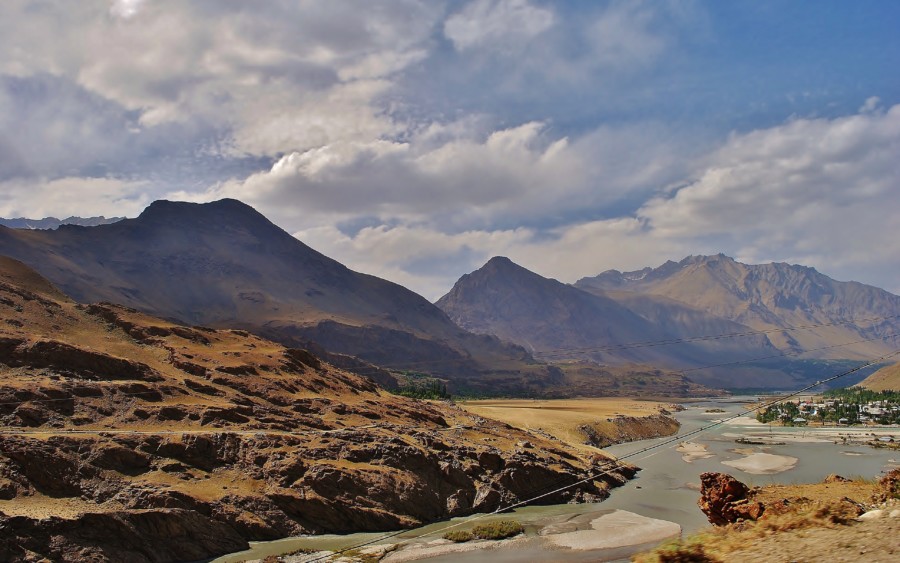
The next day Gajrat managed to repair his 30-year-old Uaza. Happiness came to me because he had to go with his neighbor to the village of Liangar to pick up his parents. He wanted me to pay for some gasoline.Obviously, I agree, provided we stay in interesting places for me. An old, rusty machine fired on the crank moved away, and so after the verandas we reached the main, hole road. The driver added gas and I felt that another of my great adventures began. To save on petrol each time we were driving off the hill, the engine stopped on me for a long time.
About 15km behind Ishkashim near the village of Namadgut we stopped at the first object, which is at the ruined Khakha Fort, dating from the third century BC and embedded on the rock. I like this building as an interesting building integrated into the mountain environment but unfortunately in terrible condition.There was a problem with the shooting as the border guard was at the top of the fort.
Then we went on a very uneven but beautiful road. On the one hand we had the rocks on the other side of the river Pajja and the magnificent mountains of Afghanistan. We often jumped over the ceiling and a few times the engine went off and we had to turn the crank. It was a great adventure. Sometimes, too, when the driver extinguished the engine because of gasoline, then we could not move. Then, less than 30km from the last fortress, we drove past the village of Darshai where the trails to Shokh Dara Valley begin. Then we rode on various difficult terrains and our Uaz fought with the Wachana Valley. For example, we were stuck in the sand on the road and it took us half an hour before Uaz moved. Fortunately, it was in a beautiful setting, which was an ideal place to take pictures. We stood in complete desolation, among the Tajik mountains, rivers and Afghan glaciers. I felt very well here, and the adventure took on blushes with every movement forward which was not so easy at the moment. When we finally managed to get out of the car, we managed to get out of the car and start driving.
Another place worth telling was the village of Ptup, a tiny settlement on the main road of Wachańska Valley, where we sat down with some locals to drink green tea and to answer a series of personal questions. The people were very friendly, squeezed my hand and looked at me. Three kilometers behind the village we turned left up and for the first few kilometers our very old and tired car climbed bravely but eventually we dived into the ditch and thought it was the end of our adventure. My driver took out the tools and tried to get him out and I went up. In the company of local children and their ass, I reached another great attraction, ie the 12th Fort Yamchun (another name Fort Zulkhomar ). This was the most impressive. It is a pity that I could not get to it because the gap was divided, but the ruins were so well preserved that they had walls and guard towers. Then, driving about 1 km, I reached the hot springs of Bibi Fatima , which in my opinion are the best in the region and also the most beautiful.
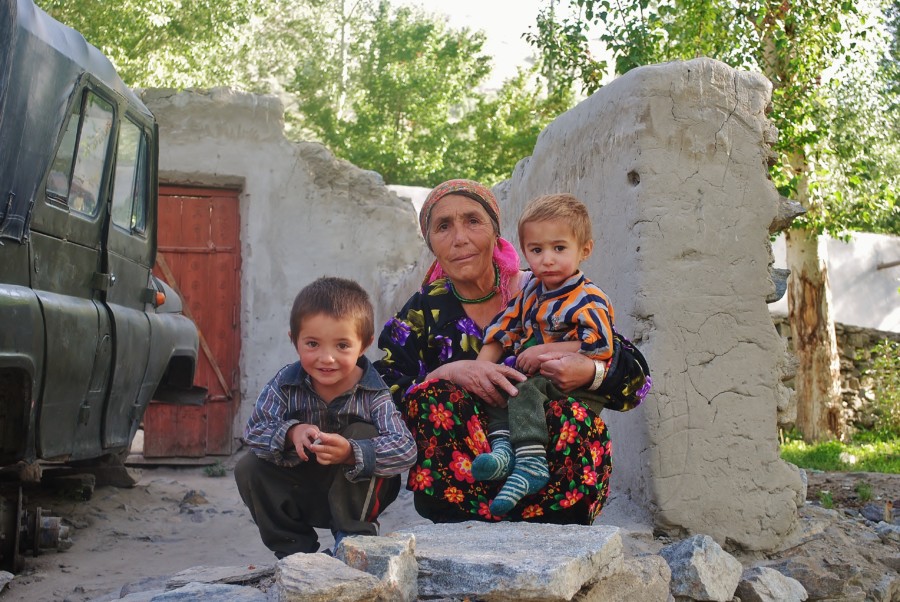
Every step of the way from Fort Yamchun to Bibi Fatima was a kaleidoscope of magnificent landscapes. It was only 1km in my life full of wonderful expeditions and on the other side this 1 km gave me so much pleasure. In hot springs, I settled in with other men in a room filled with naturally hot water. The beauty of the place was very original, because we were inside the rock and the water was running down the walls. It was beautiful. In the meantime, my driver and the team who traveled with me joined me. I could not believe that they had once again repaired the 30-year-old Uaza. After all we had about 7 km downhill from the mountain without using the engine and wasting gas. The driver was happy because he saved fuel.Then we crossed the Yamg village to pick up a random passenger and then stopped in a little more interesting, Vrang village (87km from Ishkashim). Here are the biggest tourist attractions for Buddhists from the fourth century to climb, although it is not very difficult. Unfortunately, it was getting dark, I had very little time and I did not see her well. It looks like a series of stacked blocks from rocks, smaller on bigger ones. When I went down, we went straight away because there was no time. In Ishkashim, I had no choice and therefore had to take any car to move forward. Unfortunately, 30-year-old Uaz was barely moving and he broke down all the time, so the ride was all day long.
Then (in the dark) we passed through the village of Zong where the driver bought gas because it was cheaper than in Ishkashsim. Unfortunately I had to pay for it because the driver was obviously bankrupt. After another 4 km we finally reached Liangar (120 km from Iszkas). It was also not easy as we were going to the house of the farmer again and the road was exceptionally fatal because it was crossed by long pits. Either way, we succeeded. We parked, put stones under the rear wheels and entered a typical pamirian house (the basic aspects of Pamiri architecture described above). The housewife bedded us on the platform, brought the mutton soup and then some bread with yogurt. They were nice enough that they did not want money but I gave them somani. Liangar is a small village with a strategic location as it meets the Pamir and Wachan rivers, forming the Piand river, marking the beginning of the Upper Wachan of Afghanistan. Liangar is also a very good place for many guided tours. One of them is rock climbing ( petroglyphs ). There are also three hot springs, though nothing as magnificent as Bibi Fatima and a few kilometers away are two forts: Ratm and Abrashim Qala . My stay at Liangar lasted almost two days and it ran me very quietly. I climbed the main road between houses built of rocks, I talked to people and took pictures of them. I also borrowed donkeys and accompanied the local children to the river.
I was also in the second hot springs where the water was not that warm so I would recommend the first one (located higher). At the entrance I had to give 5 somani because it is enclosed by a house made of rocks. (The area near the second source is wet, so I advise you to carefully walk on the ground.) The next morning we went for an hour or so climbing to the ruins of the Abrashim Qala fort, also known as Zong’s Silk Fortress . Our climber was quite easy since I had Tajik guides from the beginning who asked for local directions and indicated it for free. We got there in about 40 minutes and it was more beautiful. The problem occurred at the end of our hike as we had to walk through steep paths and tall bushes. Besides, in the last phase we encountered a river near which was wetland. We managed to get to the other side of the river but unfortunately I drenched down my shoes. The Abrashim Qala Fortress was built to protect this part of the Silk Road from invaders from China and Afghanistan. Today it is only an attractive ruin with the best views in the whole Wachan Valley . The fortress extends to the magnificent mountainous landscape of Afghanistan and its snowy peaks in front of you. At that point, my ride across the Wachan Valley ended . Unfortunately I did not manage to get to Kargush though I have seen so much. Well, another time.
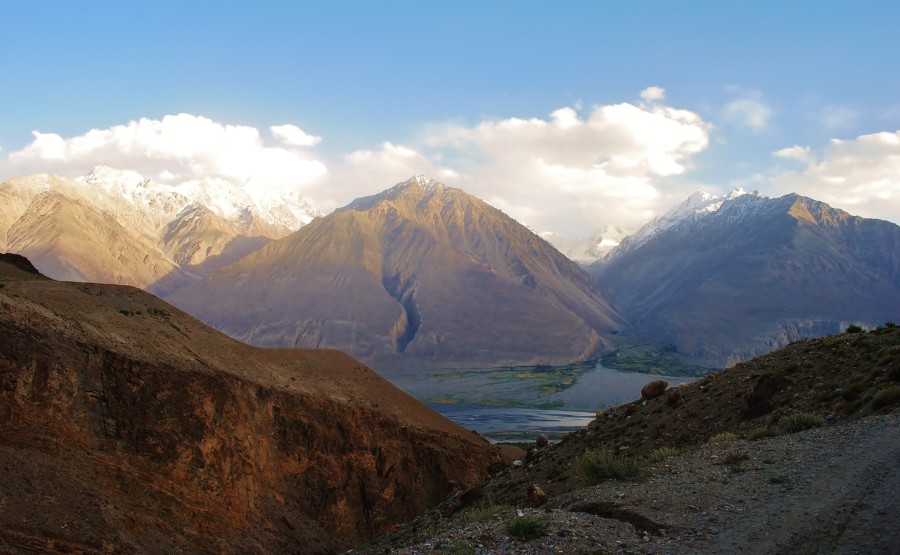
On our return we ate breakfast at the host and set off for the return trip. This time we took more people with us and the driver was happy as he drove off the hill saving gas. My way back also abounded in many adventures. Apart from the magnificent views of Afghanistan and the uneven road experience, we had a serious problem with the car when uphill. I have no idea about cars so I can not describe this part accurately but the driver and the rest of the passengers had to take out a part of the engine and then after two hours it turned out that one element broke. Of course we were in complete desolation and we could only count on ourselves. Finally, our driver stated that from the four necessary elements one broke so we will continue to go on three. We managed to move from place to place, which was a great success, but we also had luck because it was for many kilometers and the driver was riding on the off engine. In this way we reached the village Vrang , where I spent a very nice time while the driver tried to fix the missing element.One of the passengers had a friend here so he took me to tea for him. Going there watching scenic views;ie the mountains, the flowing stream and the whole setting of this place. We went to a man who worked in the Red Army and was happy to have a Russian passport and worked in Moscow. He told me that he served in Afghanistan during the invasion of the League and that he liked to be a soldier. We also talked about life in Europe and how we always get to eat dry bread.
After about two hours our driver managed to fill the missing part and moved on. To Ishkashim we reached the evening and after all the adventure but fatal conditions and fatal car we were finished. This night I also spent with the driver which was not bad but unfortunately the next morning his mother again asked me to pay her three times for the same. So I had to ignore it and pay only once, but it really was embarrassing. Last night in Iszkashim passed me very well. I slept in a traditional Pamir house, I ate a homemade apricot jam and in the morning I went to the main road where I was able to take a shared taxi. Several people tried to raise me up for a hundred dollars but I went for about 20 somani. On the way back to Khorog I stopped at another hot spring, whose names unfortunately I no longer remember but this water just cured the eyes. At this resort there was nothing to eat so the people living there gave me some noodles for free but still paid 5 somani to help them out. A big problem I had with getting out of here. I waited for any transport for about three hours until finally a Chinese bus arrived. Then stopping at the source of drinking water, while driving through Anderob , turning to the sources of Garam Charm , I finally reached Khorog. On the way I had some police control, but first of all I admired the beautiful views of the mountains, Afghanistan and its small villages on the other side of the river.
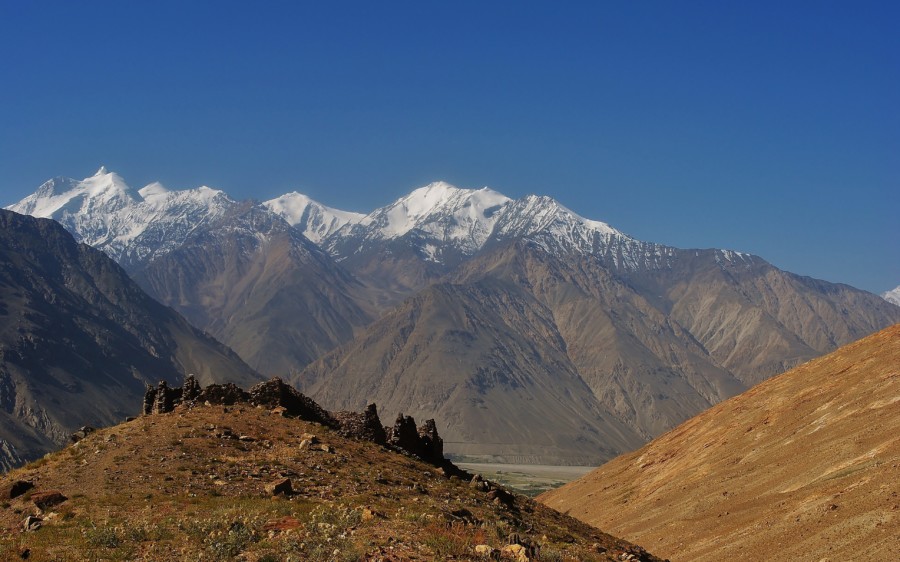
The Wakhan Valley was a wonderful experience and I strongly urge her to drive anyone in Khorog . This will definitely be a different experience than the Pamir Highway itself, which only proves how much this region has to offer. As usual there was a problem with transport, but in Gorno Badakhshan you have to be mentally prepared for it. There are many ways to get around this valley, but as always there is transport, time, and whether we have companions to share the cost. If you want to follow my plan then I advise to add to Kargush and then cross the Pamir Highway to get to Bulunkul , then continue through the main route to Khorog . This is a classic loop from which there are also many interesting ridges.
My last day in Khorog
At Khorog I stopped at Pamir Lodge again but this time I did not spread the tent in the garden because I was too tired. I slept on the veranda for $ 1 more and got a bucket of hot water so I could finally wash. I also went to a pub, on the internet and spent time in the Central Park. It was a very relaxing day for me.
Driving from Khorog to Dushanbe (608 km)
Normally, transportation to Dushanbe has to be done from the main bazaar where there are always plenty of off-road vehicles. But I was lucky because I noticed the driver before Pamir Lodge and thus arranged the transport for myself, a Scot, an Englishman and a German. Besides, I also needed them so that we could share the costs. The enjoyment of this person cost $ 50 which was not at all expensive. So we went on a journey full of wonderful landscapes. When we left Khorog we said goodbye to the Afghan consulate and after a while the police stopped us to check our passports. Our road was very interesting but also very tiring. On the way we played a short football match on the island between Tajikistan and Afghanistan and then we also stopped for lunch lying down, near the lake and in the background of the mountains. For a long time on the left side of the road we had an interesting view of Afghanistan , the Afghan villages and the people who built the primitive roads on the slopes of the mountains. In the meantime, the police checked us from time to time, taking water from the rocks and stopping at the pictures. Before entering the highest point of our journey (Sagardasht Pass 3252m) again checked us militia but we were also on a delicious dinner. We lay down on a wooden platform on the edge of the mountain and were served a roast lamb with onion and local bread. For dessert we also ordered honey. All this food was of course fresh and came from the surrounding mountains rather than from a farm or factory as it is in Europe. In the last phase of our journey we also saw bulldozers working on road construction. The entire process was, of course, “decorated” with the posters of the President of Tajikistan, whose pictures are abundant throughout the country. Finally after a 16h ride, completely finished and with aching back we reached Dushanbe.
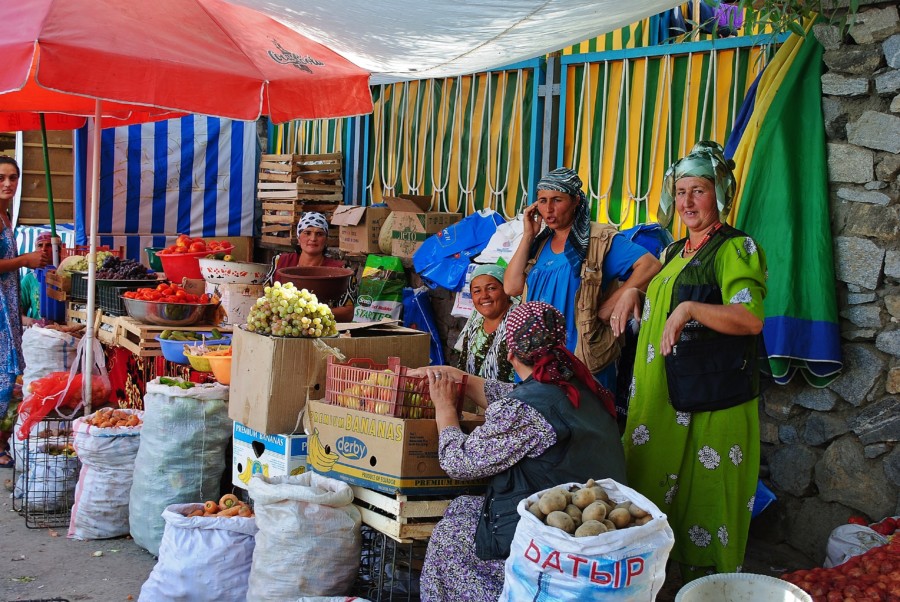
If anyone has the time and fancy, I suggest to share this trip and stay overnight at Kalaikum through which I also traveled. I do not guarantee, however, how it will be transported from there, which can actually go out to the travelers in favor. From Kalaikum you can see the area and stay in eg Tajik village Yoged , on the other side of the river with Afghanistan.
Gorno Badakhshan – summary
The Autonomous Region of Badakhshan is one of the greatest adventures of my life despite the fact that I have traveled most of Asia. It is not an easy place to travel but it is more interesting. You must be patient here in waiting for the transport and withstand the conditions of life and travel difficulties. I would recommend my trip plan through the Pamirska Trasa and the Wachań Valley, although if I had to do it again I would probably add a lot of other trips. To my consolation I will add that the relief in the hardship of the journey brings hot springs that are scattered throughout the region and nice, hospitable people. Anyway, this is a great experience that gives you a good bone.
Dushanbe and around
Dushanbe
(Avondo Hotel, Haji Yakoub Mosque, Tsum, Union Building Writer, National Antiquities Museum, 1500 years old Buddha, National Bekhzod Museum, visit to lonely women, “KGB”)
We reached Dushanbe late at night and were worried about where we would sleep. We heard legends about the hotels being very expensive in the capital of Tajikistan so the Englishman came up with the idea that we could get off the city, lay down tents in the field and sleep for free. The Germans, Scotsman and I also agreed on this idea because none of us was withdrawn. The driver took us to the friends in town where we paid only 10 somani, which is about $ 2. My friends slept in a stinking room while I was outside. I threw myself on a wooden platform where I usually drank tea and spent three nights there. I slept under a tree, and the goat was always in the morning. Let me remind you again of the super promotion that is only $ 2. In addition to many free nights in the deserts, beaches and mountains, I paid the least for a room in India and Bangladesh, which is even less than a dollar.
The next day I talked with the hosts about life in Tajikistan and about my in Europe. I made contact with a young Tajik who was just building a house on the land of his parents because “the time came” for the wedding. He also said that he did not have a wife yet, but when the house will be and his wife will find. The conditions at this place were worth $ 2.
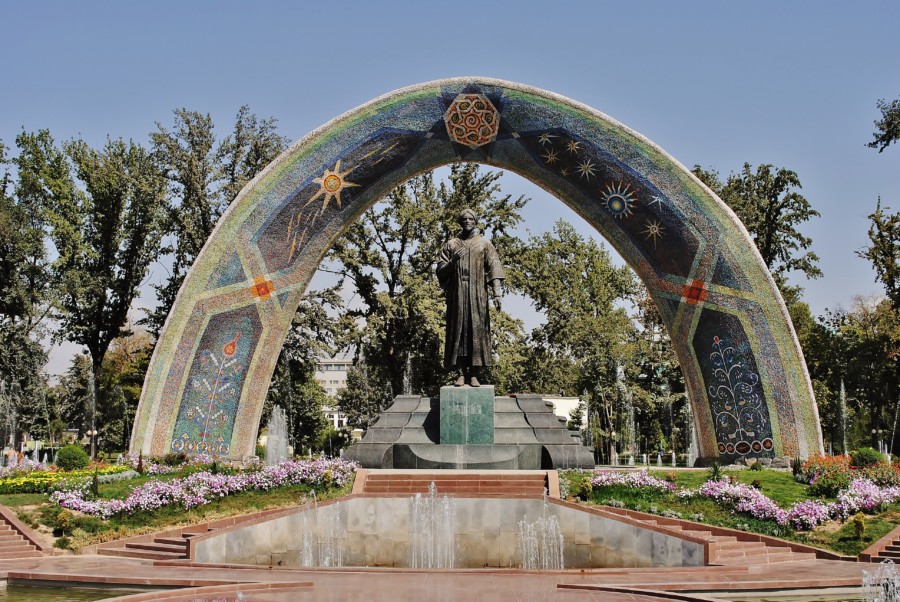
After breakfast I went to explore the city. I got on the bus and drove for about 10 minutes towards the center which gave me a good view of the city. Dushanbe (formerly Stalinabad) is a very nice, green and pleasant city. On the way there were some interesting objects such as a university, although the people were curious as well. In Tajikistan, great value is attached to tradition and I mean the national dresses worn by women. I got off at Liberty Square (Maydani Azadi) where I saw the great symbol of the “low flight” Dushanbe or the huge statue of the eternal ruler Ismoili Somoni . I will add that there was once a monument in Lenin and that there is also a post office and a red government building on the same square.In this square, however, I advise against greedy policemen. One came to me saluting me solemnly and took me to his boss, sitting on the curb. After thoroughly checking my passport and asking questions about my property and earnings, they asked me to give them 5 somoni ($ 1) because they make only $ 50 a month. I gave them pity and left. Then I went to breakfast at a nearby restaurant for another very promising price ($ 2.5). Then I went to the Central Park called also Rudaki Park , which I admit that it is barzo pleasant place. In front of the entrance there is a nice gate and a lot of greenery, including exotic flowers.The monument to Rudaki, the most prominent Persian-Tajik poet, lived at the turn of the 9th and 10th centuries. The monument itself was very interestingly built and was under a mosaic-shaped arch. Besides, the poet’s monument was a fountain and there was a lot of greenery around. I admit that especially given the post-Soviet monuments of Central Asia, it is possible that Rudaki’s monument was the best.
From the park I also saw the Presidential Palace, which is a great monument of money with white color, with nice greenery and fountains. Then walking down the main street I reached the Avesto Hotel and turned left.There was one of the larger mosques in Dushanbe or Haji Yakoub Mosque . Considering that I have already been to many Muslim countries and have seen many mosques, this one has not impressed me very much, although the mosaic of mosaics on the walls is worth mentioning here. Besides, I saw what was always the minarets, the dome and the head of the mosque, who after asking me a few personal questions threw me out of the object for short shorts. This mosque is also recommended, the more so that it is located about 10 minutes walk from Rudaki Park. Then, as I walked along the main street, I reached the Tsum’s goods store, a large post-Soviet block filled with merchandise. I bought a shirt with the contours of Tajikistan printed a little crooked. I liked it so much, but it was a pity that this time I had to taste it. I paid 40 somani for about $ 8. Soon I turned left and reached the very interesting Union of Writers Building (Ismoili Somoni) . The reliefs of Persian writers are depicted on it, which further highlights the Persian origin of Tajikistan.Then I went back to Tsuma, got on the bus and went to the beginning of my walk or Freedom Square (Maydani Azadi) .
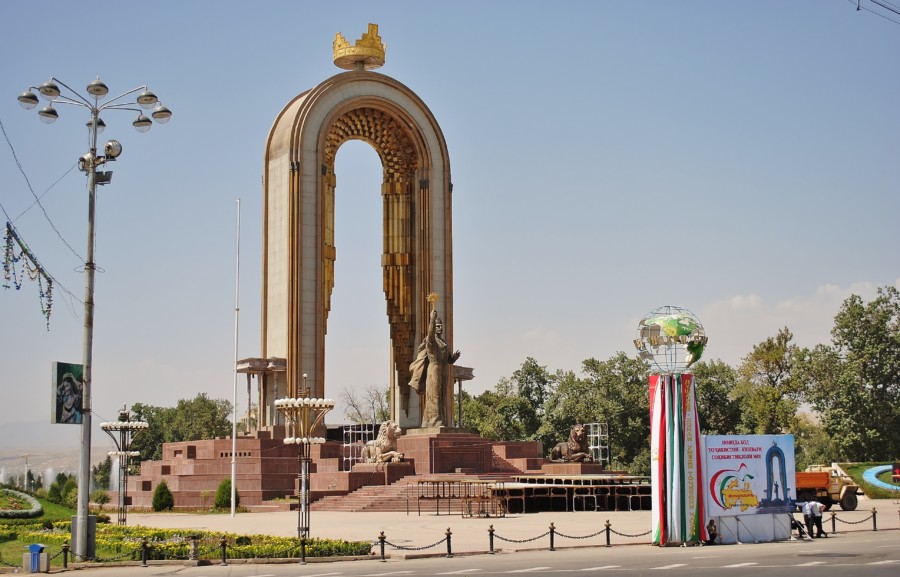
Here I avoided the militia I went to the post office and then going about 15 minutes I reached the National Antiquities Museum . I liked it very much because there were many interesting exhibits on Tajikistan’s art history. The 13-meter-long, 1500-year-old Buddha , discovered in 1966 and originating from the erstwhile Kushan, deserves to be remarkable. It is the largest in Central Asia. It can not be photographed, but I managed to do it because I had a nice guide. Also, take off your shoes before entering this museum. I also do shopping in a museum shop. It is cheaper than in tourist shops and in Tsumas. Then I went to the Bekhzod National Museum , which is something that must be seen in Dushanbe. There are many expositions of ethnography, art, archeology and natural history, which I think is a small museum of the death of innocent animals. The images of Rudakie and the passing of Pamir were the most memorable ones. As in any museum in Central Asia, one can not miss the big picture of the president of Tajikistan and pro-Russian propaganda based mainly on defeating the Nazis. The lesson about Tajikistan’s art and culture was a pleasant experience, but he had a great article written about Comrade Stalin’s eyes. Another interesting painting on the glaze was the presentation of Tajik women dancing among Soviet soldiers and holding Lenin’s poster.
After leaving the museum I just walked around the city. I have seen many other interesting objects such as theater or ingeniously built restaurant. I was on a very cheap and good kebab, once again saw the great statue of Ismaili Somoni and then came back home by bus. After going out into the street I went to the store where I was supposed to spend a while and I stayed two hours. The owner was a single mother who just wanted to talk to someone. She gave me tea and we ate a piece of cake. But it was one of the saddest experiences of this trip because this very lonely lady gave me some more candy for the road and saw me cry when I left. Well, it was bad but I could not extend it.
I came back home about 2am and saw everyone was on my feet. An Englishman and a Scot were arrested at night by a man who claimed to be a KGB agent and wanted money from them. The cheater was so brazen that he came with them to our hosts’ house and demanded money because apparently one could not walk the night after drunk. I thought they would just throw it out of the house but they were all scared and they really believed it. It took me a long time to calm down and explain that he was not from the KGB.It was a funny but tragic situation as people continue to tremble at the news about the KGB.
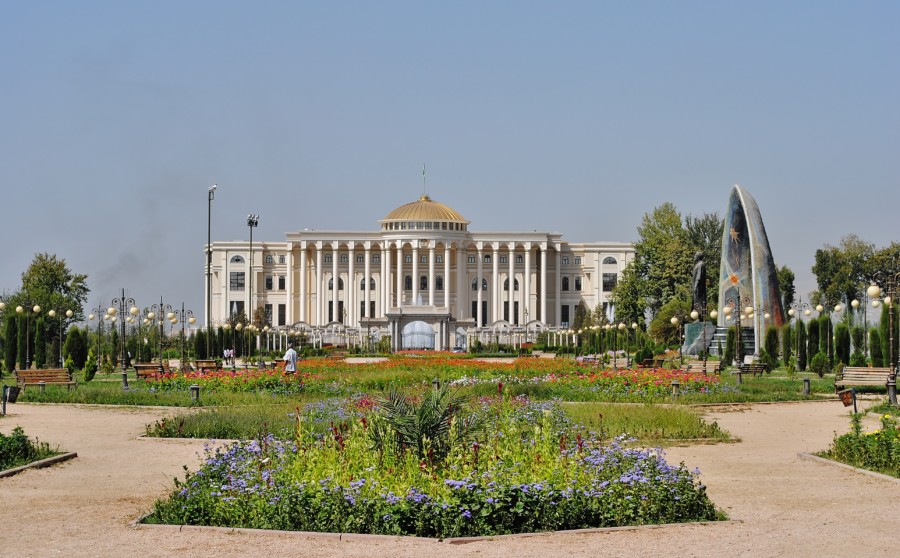
In summary, Dushanbe is a very pleasant town where you can spend at least two days. There are some interesting things to see, nice people, good food and unfortunately cops spoilers. I would recommend.
How to get to Hissar?
Before I go on to describe Hissar I would like to explain how I got there because it is not always so easy.First I got a bus going down the main street to the great monument of Ismoili Somoni at Liberty Square (Maydani Azadi) . From there, from the opposite side of the big monument, I got on bus number 8 and went to Zarnisar Bazaar. Here I had the choice between a minibus and a shared taxi for the whole dollar.After less than 30 minutes I got to the town of Hissar on the main market. Then I hitched another 7km between the cotton fields and several hundred years old ruins and fortresses ( kala in Tajik).
The return to Dushanbe was as easy. First hitchhiking through the cotton fields to Hissar station. From there I had a nice bus ride with locals and Zarnisar Baazar got to Tsuma with a mixture of local buses and on foot.While driving back I was witnessed how you can go for free and still make money. An old man with a long beard was praying all the way, and the people pressed him into small hands.
Hissar
30 kilometers west of Dushanbe, behind the mountains and among the cotton fields lies an ancient village called Hissar . The main attraction is the 18th-century gate called Darvaza-i-Ark . Once upon a time it was the entrance to a magnificent fortress but unfortunately the red army destroyed it. The image of the gate itself is so popular in Tajikistan that its picture is on the banknote 20 somani. At the gate and in the center of the guard towers you can enter from behind the hills. This experience offers nice views. In front of the gates lie two 16th century medreses called Medressa-i-Khuna and Medressa-i-Nau . At first there is a museum, which is spread out in small chambers with direct entrance from the main courtyard. There are many old items including ceramics, costumes and jewelery. Another object that draws attention is the 16th century mausoleum of Islamic teacher Makhdum Azam . There are also caravanserai fumdamentas built in 1808, which are what remained after the settlement taharatkhana . After the tour, I went to the shop next to the main gate. For the funny money I bought bread, sausage and grapes, which in Tajikistan is a lot. Next to it is a holy place where it is nice to sit in the shade of trees.
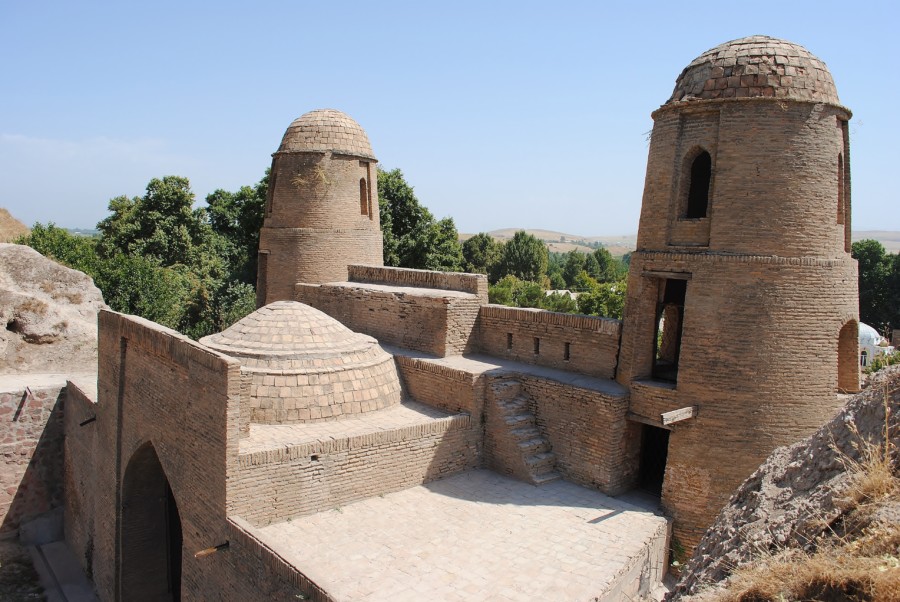
In summary, Hissar is a very nice trip from Dushanbe and it is very easy to get there. Besides, Hissar is not just a monument. I did some interesting photography here, and besides, the surrounding cotton fields and the town itself also provide an impression.
North Tajikistan
Road to the north (M34)
Great mountain views, delicious mutton in mountain hills, Anzob Pass, tunnels, turn on Iskander-Kul, Ayni and Varz-i-Minaret, Shakhristan Pass, once again scenic mountain scenery)
Route M34 to the north, towards the Tajik Fergana Valley is an unforgettable experience and one of the most spectacular trips in the country. Before I left, I was waiting for a bargain at Dushanbe for a place in a four-wheel drive car. A shared taxi is the only possible means of transportation and only off-road because only this type of car is able to break through the high mountains. After leaving the capital of Tajikistan, we first drove long past the turquoise, rushing river, of course on either side of the mountain. I recall that the mountains cover 93% of Tajikistan. Then the tour led through mountain streamers and no matter where we were the views were magnificent and after a while even more magnificent. Once again we stopped for dinner in a wonderful mountain scenery. The menu was not varied as there was only one dish in the whole pub and I added that it was the only pub in this part of the tour. I got here deliciously cooked pieces of ram with onions and of course green tea. Each time the Tajik mutton is a wonderful experience and always at an unbelievably bargain price.
Then we passed Anzob Pass (3372m) and again I would like to mention the magnificent views but not this time. The government of the Islamic Republic of Iran has funded long tunnels in the mountains, employing cheap Chinese workers. Not all of them were ready because of the frequent floods, but many of them passed what saved around two hours of driving. One of the tunnels was a poster of the President of Tajikistan, handing over the President of Iran. Inside the tunnels were terrible.First of all it was dark, secondly very wet and it was necessary to go carefully to avoid falling into heavy objects. The tunnel itself was also an adventure. It is also worth mentioning that those who want to go to Lake Iskander-Kul have a chance to do it on this route. Somewhere between Anzob Pass and Ayni village is a turn left with a signpost on the lake. I personally think that using this road is a very bad decision but everyone has a free choice. Then I will tell you how I got to one of the most beautiful mountain lakes in the world.
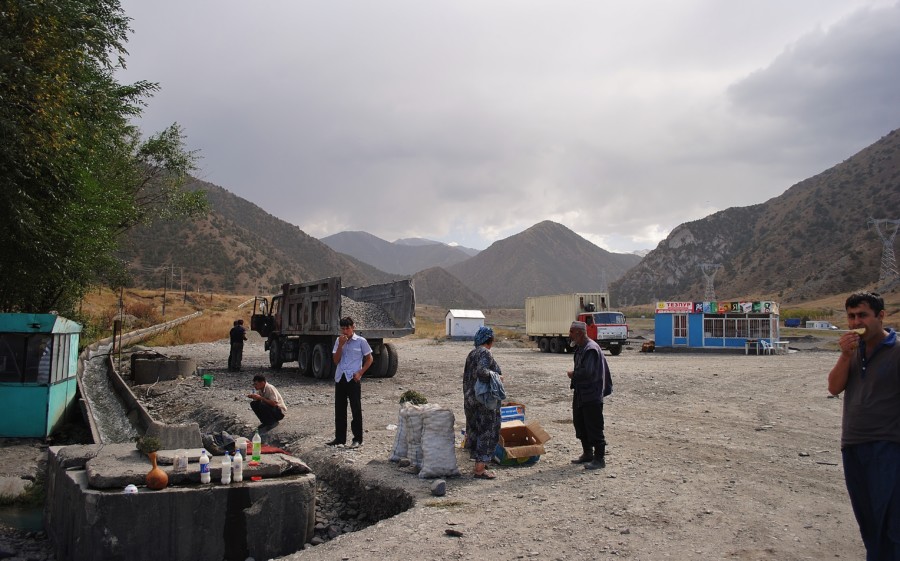
Next, we were going through a small, uninteresting town called Ayni . It is worth stopping here to take a picture of the eternal minaret named Varz-i-Minaret . It is 13.5 meters and it is in a tragic condition but worth it. Today it is covered with transparent material from all sides. Another important point of crossing was Shakhristan Pass (3378m) . We climbed long and the views were very scenic. When we were leaving, all the compulsory police checks had to come from all over, and I had to say goodbye, but they finally let me pass. In the last part of our M34 trip we had another obligatory stop because the driver gave the car a wash. Walking along the highway, among the beautiful mountain landscapes, I once again found a nice person. The man who sold the apples pressed me a few to power. After 10 minutes from here we reached Istarawshan .
M34 is one of the best “road experiences” in Tajikistan. I guess I will never stop admiring this country.
Istaravshan
(Fabulously cheap hotel, sightseeing sights, great mutton skewers, chat with the militia boss, professional shaving, funny prices, very nice people)
Istarawszan is a small historical town in the north of Tajikistan. I spent three nights here and I do not regret even though the guide recommends only one day.
The driver dumped my very dirty and ruined backpack from the roof, and then started looking for a hotel.As usual, I headed the price and right at the bus station I found a room for 10 somani (about $ 2). The service was cheesy and very curious, the room was syf and there was no access to hot water. I remember that there was no access to cold water, so I had to wash the fountain outside.
For a few days I had a lot of time. First I went to the main market where at the sight of the only White wanted to sell dollars. Well I visited the bazaar dedicated solely to onion, I took pictures of people and I had fun. The bazaar on which they sold fruit, meat and gatta was also very pleasant. Basically I recommend the bazaar first. Then, walking through the stalls with melons and watermelons, I headed towards the historic part of Shahr-e-kuhn . I walked in small, narrow, winding streets, between gray houses, clay and sawdust. First I came to Kök-Gumbaz, a fifteenth-century mosque with a huge blue mosaic-covered dome.In the middle was a square with a small garden and several chambers requiring renovation. It was not important to me because it was a very pleasant, peaceful place. Before the mosque local boys were playing football but at the sight of tourists they stopped and searched for contact. Two of them helped me in looking for the next facility and as we walked through the small, poor streets we reached another mosque. This time it was very interesting, 19th century Hauza-i-Sangin Mosque . I think I liked it most because it was not like a typical mosque. It was rather a small Buddhist temple with carved pillars and nicely painted ceilings. Outside was the garden, which made it possible to rest in this place. I sat down with my young guides at the empty pool ( lotus ) in the shape of a lotus flower and in the shade of fruit trees. We went mostly peaches but also apples. In front of us was a tomb where Shah Fuzail ibn-Abbas was buried.The Mosque and the Hazrat-i-Shah mausoleum were also nearby, but I did not like it.

It was my first very nice day but it was getting dark and I had to return to my very cheap hotel. On the way, however, I hid on the main street as my attention was paid to people grilling skewers. As every evening they spread out with their barbecues, tables, tea and full service at an extremely low price. I spent so many hours sitting in the street and mostly answering questions about my alleged “wealth”. Kebab with onion, tea, lychee and good company tasted delicious. After dinner I returned to the hotel but unfortunately I was not able to go straight to the room. First, I had a conversation with the boss of the militia . Mostly he asked me questions about my earnings and complained very much about his. He said that as head of police in this city he earned only $ 50 and he would not even have enough for food. It was a very nasty conversation but I felt awkward and lucky to have to go somewhere. He kept squeezing my Polish passport.
The next morning I went for breakfast to the restaurant and again I was pleasantly surprised by the price.For three eggs, bread and tea I paid only $ 1. Then I went straight to the old town to visit other places. On the other side of the village, at the top of the mountain stood the Mug Tepe, which made a great impression of the gate, built in the shape of a mosque with a blue dome. Once a fortress stood here, but today it was only its remains, because Alexander the Great in 329r BC attacked this whole city. The magnificent gate is in excellent condition but because it was built in 2002 for the 2500th anniversary of Istarawszan. The trip to Mug Tepe was very pleasant and I talked to people who always looked for contact with me. Getting to the top and getting to the gate was a nice experience too. On the way back one man took me to the next object free of charge. It was Mazar-i-Chor-Gumbaz or a group of temples with a high minaret, a new mosque and a mausoleum. I would highly recommend, especially since it is close to Mug Tepe.
Then I walked alone in the town and talked with people. Children were playing alone in the narrow streets in front of their homes, and each time I was an event of the day. The men met told me that they were familiar with the construction and asked me to get them to work in Poland. Istarawszan was also a very tragic place because as everywhere in Tajikistan poverty was squealing. On one of these streets I was again brought to one of the more interesting objects. This time it was the 17th century Sary Mazar temple complex. There was a mosque, two tombs and 600-year-old trees. All the time I was accompanied by young boys who filmed me and took pictures. Of course there was a lot of laughter, fools and questions.One of the nicest experiences was when I went to a professional barber and was shaved for free. They did not want money because I was a guest in their country.
This day also ended with delicious ramen skillet with onion and lychee in a good company of local grilling.

Istarawshan was a wonderful experience and I sincerely recommend it. At first glance, the town can conjure up mixed feelings, but after closer exploration of monuments, small streets and local spots, it turns out to be one of the best villages in Tajikistan. I do not have to skewers?
Sanatorium near Istarawshan
A few kilometers behind Istarawszan is a very pleasant sanatorium. You can take a dip in hot water and get a full body massage. I unfortunately came on Sunday when it was closed but I met in the garden a nice woman who called the massage therapist and came to a special order. I took a nice shower and then 40 minutes full body massage. I could massage a young girl but from my experience I know that women are more likely to “melt” and a real massage can do a man because he has more strength. First, it lubricated the oil and then improved the circulation with a strong rubbing. Then he did a whole body massage, several times setting my bones. For the whole I paid only $ 3 although the price on a weekday was $ 1. I went to the sanatorium and picked up apples and pears.
Sanatorium as much as possible.
Kodżand
Kodzhand is the capital of northern Tajikistan and the second largest city in the country. The town is also one of the next ones, founded by Alexander the Great on the banks of the Syr-Daria river. In 1986 Kodzhand (then Leninabad) celebrated its 2500th anniversary. This city is not the most visited by tourists despite the monuments and museums worth seeing.
Kodzhand is well positioned in economic terms in the background of Tajikistan.
Kodazand visited as a one-day trip with Istarawszan. The ride lasted more than one hour. First, I went to the symbol of the city, or to the 10th century citadel , which used to have 7 gates and 6 km long. Today the citadel is quite small and its central point is a large, massive gate with impressive doors. These are the entrance to the Historical Museum of Sughd . The guide said it was not worth going in but I loved it.Immediately at the entrance stood a statue of Timur, or local hero of this province, who famously defended himself against the Mongols. There was a rich exposition of ceramics, weapons and a coffin from the 1st century. Also under the glass floor in the same room was an exhibition of broken dishes from the 1st century. The lower floor was a chamber representing the life of primitive people in these areas. Showing men here at work and women with children. One of the best exposures was the bas-relief depicting the host of Alexander the Great’s life from birth to death. There was also a Persian motif in the form of a sculpture from Persepolis. (I said earlier that the Tajik have Persian roots). Unfortunately, as is usual in the museums of Central Asia, there was also a small propaganda corner about the “fantastic” red army.

The next museum located in the citadel was the Museum of Archeology and Fortification . It was closed but I talked to the workers outside and after asking a few questions they got me a free entrance. In this museum I have seen some interesting photographs from the 19th century, large jugs and citadel designs, as it once was. The good thing is that you can go to the top and have a good view of the countryside.Unfortunately, when I came in I realized that it would be better not to take pictures here because of the rifle army just before me.
If I should recommend something else, I advise to pay attention to the monument to the symbol of Rome or the she-wolf feeding Romulus and Romulus. This monument is located in close proximity to the main gate to the citadel. Then through the park full of old carousels I reached the river. I crossed the bridge and reached the 22 meter Lenin Monument, which is the largest in Central Asia. Traveling through this region I have seen many, but this was really great and the companion was presenting as if he was supposed to say something clever.
My last experience in Kodzand was the Paszanbe bazaar, which in my opinion is the nicest place in this city.From the river I had to walk the kilometers to the bazaar but it was a pleasant walk. On the way I stopped for ice cream and delicious milkshakes. Then, passing through the stalls with corals and street shoemakers, I reached the big square. On the left side I had a good view of the complex. It was a white marble mosque with beautifully carved pillars, Sheikha Massal ad-Din mausoleum from 1394 and an impressive 21 meter minaret from 1895. The whole thing was really impressive, the more I felt the burden of time. The Bazar Paszanbe is the best-stocked Central Asian market. Entrance to the bazaar is decorated with a large, neoclassical gate where the ceiling is painted pink and yellow, or two colors I hate. Lonely Planet’s guide described the architecture as “Stalin meets fairy tales 1001 nights”. Perhaps there is something in it. In the middle of trade wre all over. With my camera and camera, I quickly became an attraction of the day and made contact with the sellers of meat and bread. Outside was a huge bazaar and only devoted to the onion and another only to the grapes. These two are certainly in Tajikistan in abundance. The Pashanbe bazaar is a great attraction and a visit to Kodzand without coming here is lost.
On the way back I stopped several times for milkshakes and so slowly got to the shared bus going to Istarawszan.
This pleasure cost me 6 somani which is just over $ 1.

Shaving in Tajikistan.
Ride to Iskander Kul lake
(Adventure riding, shopping straight from the field, another adventure)
I left Istarawszan on M34 and fate that I was hit again for the worst. We rode very slowly and then we were still on police checks. Then we barely entered Shakhristan Pass (3378m) and we had to push him a few times. Then after arriving to Ayni again I had a chance to look at the 10th minaret and just after Ayni was turning to the lake.
The road to Lake Iskander-Kul is not easy. There are two paths and they differ in that one is fatal and the other is even good – in certain stretches of course. The driver was nice enough that he took me 50 somani from Istarawszan to the taxi stand (first kiszlak) and from there I had to bargain with taxi drivers to take me to the next 15km. Public transport should of course be out of the question. I spent about two hours looking at the river and mountains. Finally the driver came to the lake as he drove further than the Iskander-Kul and said he could lift me up. Unfortunately, it also lasted because first had to do shopping. He said he lived so high that he did not grow up so we went around the farm looking for tomatoes. In one village everyone went to the field and picked up, and in order to be faster I also collected. In the end, my driver bought 3 tomato buckets, 20 jars of preserves, other vegetables and fruits and half of ragged skin. Then he filled 3 gasoline kits and set off. Briefly, I thought. The route led through picturesque mountain scenery along the river and the high mountains of Fans . After a few glittering streamers on a very uneven road we reached the Iskander-Kul lake.
I try to also my road reports were described as accurately as during transport very well know this beautiful country, its people, life and customs.

Fans Mountains
The Fans mountains are an exceptionally beautiful and very popular trekking area in northern Tajikistan.They are quite close to Dushanbe and Samarkand. There are many scenic routes of varying difficulty, which also involve different costs as you must take a guide and transport.
I saw two pearls of the mountains of the Fans. It is the lake Iskander-Kul and seven the Marguzor lakes .
Lake Iskander-Kul (2195m)
Lake Iskander-Kul is an exceptionally beautiful gift of nature. It is located 24km from the main road M34 and is accessible without the need for extreme climbing, which does not mean that it is easy to get there.Lake Iskander-Kul has a turquoise color and is surrounded by mountains.
When I came here I stopped in a depressed center called Turbaza. It was an area with several houses and a bar with access to the lake. I had fun here because there were two ripped Russians and a couple of Swedes in addition to merry Tajikans. I only paid 10 somani ($ 2) per night and they cooked plow and drank green tea. In return for a cheap price, but first of all, I also chopped wood for fuel with good will. Together we had some fun evenings.
The Iskander-Kul lake was exceptionally charming, and the quietness and silence of the place gave it a chance to rest. Apart from the main lake I also went for a walk among the rocks, along the river to the waterfall. I’m close to Turbine because it’s only half an hour away. The whole area is so beautiful that you can spend hours here. The road is not always good, and in many places it does not have to climb on huge boulders. The waterfall itself and the surroundings are definitely worth the whole venture. Besides, I went to another mountain to see other smaller lake. The whole area made me rest from the constant handling of the transport. I felt very good here and the Iskander-Kul was one of the most beautiful mountain lakes I had the pleasure of seeing.

Ride to Penjikient
Tajik, who cooked all plov over Iskander-Kul and who escaped for two weeks from his wife had a four-wheel drive vehicle. For a promotional price he packed me, Ruski and a pair of Swedes. We quickly drove along the edges of the Fan Mountains, where riding was a pleasure. Sometimes it was a bit dangerous but we had a very good driver with experience in this area.
Wherever we went the views were as usual beautiful: mountains, turquoise river, people, sharp corners and unfortunately the police stopped us. Cops said they were looking for refugees from prison but in my opinion they just stopped every car to squeeze some cash from the drivers. On the way we also had a view of some of the donkeys and some very interesting bridges.
After a beautiful and fascinating drive we reached the town of Punjik.
Penjikient
(Outdoor restaurants, Rudaki museum, fruit bazaar, antique Penjikient)
The Punjabi is a pleasant Tajik town lying on the Zarafishan River. There is an interesting mosque, a small Rudaki museum and the ruins of the old town of Punjabi. Besides, there is also a lively fruit market and several outdoor restaurants where prices are more than promotional.
I got here from Iskander-Kul lake. The driver dropped me off at the main bazaar and went with the Swedes to search for a hotel. We wandered in search of something that would be cheap enough, but as a rule, everything was too expensive. Finally we got to the Hotel Pendjikient where the Swedes had to spend $ 20 a night and I was only $ 5 because i am a Pole and i speak a little in russian. By the way, traveling around Cen- tral Asia is generally much cheaper on a Polish passport but not as cheap as on a Russian one. I spend most of my time learning about the town and its people. We were together in some very nice pubs, on fresh juices and rams and rams. Every time it was great. It was also fun to have a bazaar where young Muslims posed for photos and helped pick watermelons. From the boring objects I saw a mosque that was quite spectacular but still not a fan of Islam.
I was also in the Rudaki Museum where I saw interesting frescoes, antique tools and many other interesting objects from Saraz. Of course, there was a portrait of Rudaki and his great monument in front of the museum, as Abdullah Rudaki was the father of Persian poetry and the Tajik people were from the Persians. Another important place I went to was the Antique Pioneer founded in the 5th century and deserted in the 8th. Today there is not much to see except ruins and only the outline of what used to be one of the most vibrant cities on the Silk Road . I saw that the foundations of the bazaar, the arches of the ceiling and the citadel were still here. However, you have to look at the whole object very carefully, because from a distance the whole looks rather like dug trenches.

The tourist is not a city to which many tourists come, but you can not miss it if you choose the road to Uzbekistan just this way. Depending on the time I advise you not to hurry and spend at least one day here.
Marguzor lakes (expedition to the Seven Lakes)
Being in Pendikikient, I went to the next Pearl of the Fans , the Seven Lakes . Well, at the time I was traveling with the Swedes, because I did not have to pay myself $ 100 for a jeep. For super frugal people who like a great deal of discomfort and have a lot of time I can advise that there is an option to get a local bus to the first lake and from there you have to walk to every next one. The return service is basically in place, but in my opinion it is a mistake to find what is one of Tajikistan’s charms.
The 20km chain of Marguzor Lakes was picturesquely integrated into the mountains. The lakes were of different sizes, at different distances from each other and different color. Some were turquoise and others were light green. The driver stopped at each of them and waited for them to bypass and look carefully.There were a few small villages consisting of cottages built of rocky rocks and curious people. This tour was a great way to get to know one day in the Fan mountains and the nice and hospitable people living there. On the sixth lake was the village of Marguzor where I spent time riding on donkeys. I understood that I was most happy because of the simple things like riding a donkey.
The return trip gave me another chance to see all the beautiful lakes, people and poor but lovely homes.
Marguzor lakes was my last adventure and last contact with nature in Tajikistan which does not mean I put them in the last place. It was beautiful, lovely, wonderful. Anyone who reaches the Punjabi advise me to visit the Seven Lakes .
Transport to the border with Uzbekistan
There are several ways to cross the Tajik-Uzbek border. I was driving a local bus from the Punjai. 22km went smoothly and the road was not as bad as other tourists said. I paid ridiculous money as usual.
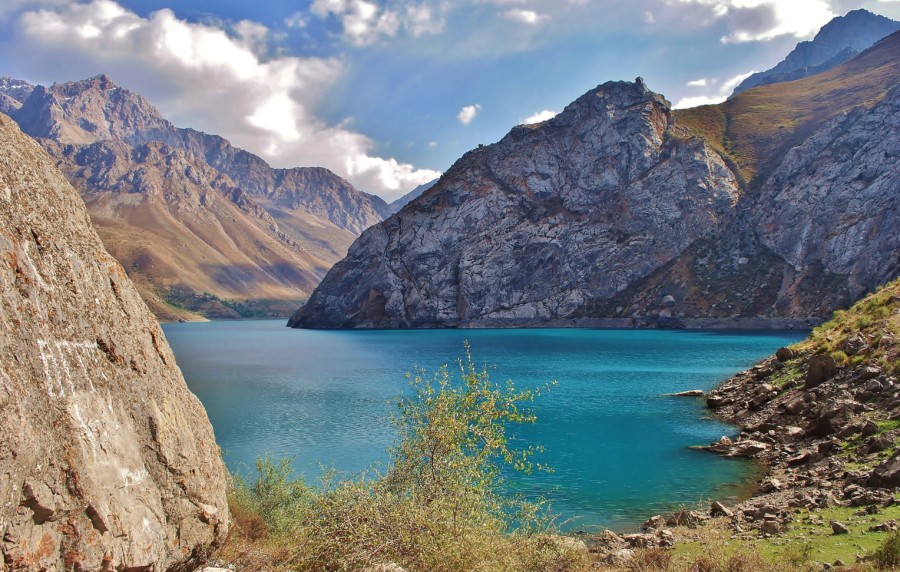
Tajik border
Generally, there is no problem with it, but it can be a problem with people working on the border. They are looking for any reason to get some money. I did not have any problem, but the Swedes wanted to download $ 50 for anything. With the Japanese also because it was about $ 10 more than he testified on the statement. This is not the worst of the bounds but if the guards say openly that they make only $ 50 a month and ask for help then you can expect shamelessness. I heard from the same one that if they want to dig something they will dig up so it is better to pay.
Summary of Tajikistan
From the point of natural beauty Tajikistan is one of the most beautiful countries in which I’ve ever been. The mountains and turquoise lakes are amazingly beautiful and people are always friendly. Tajikistan is also one of the biggest unforgettable challenges to reflect on the fact that we should appreciate the luxury we have in Poland. I am talking of course traversing the Pamirska Trajectory and the entire Badachszan Mountain Region. Other fun are, for example, hot springs, donkey rides and some antique objects. Problems can only be with the militia but they can not be avoided. You should politely give the passport for inspection and politely answer all questions, most of which is due to pure curiosity bored to the pain of militiamen and soldiers.
To sum up, Tajikistan is beautiful and my trip to this country was one of the most interesting challenges of my life.
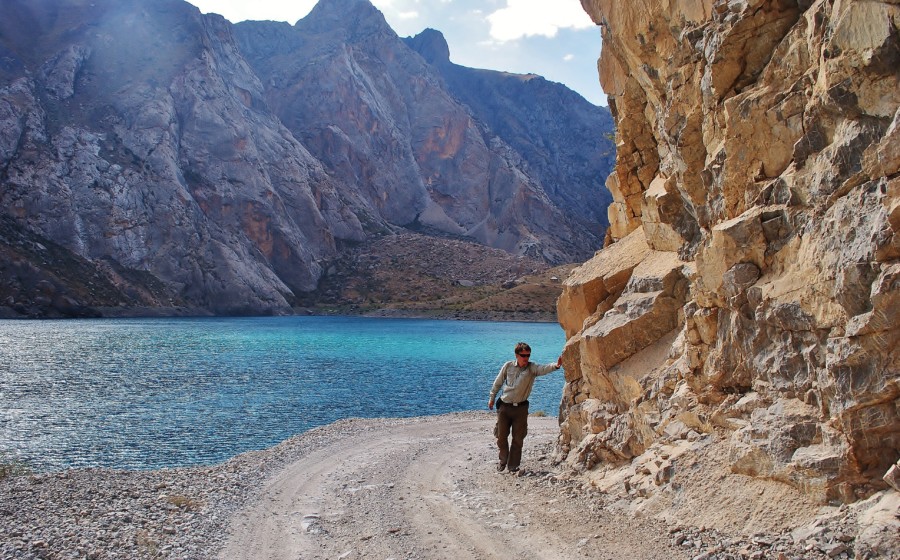
Martin Malik – a tireless traveler in distant regions of Asia. The trip to Tajikistan was extremely successful and beautiful.



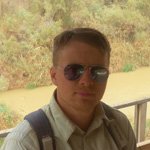
































~Karol Werner
Great travel report! I was also in Tajikistan and in the Pamir this year!
~Ron
Good material for a book.